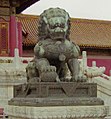「ライオン」の版間の差分
m ハイパーリンクをいくつか追加した。 |
ギルに |
||
| (34人の利用者による、間の44版が非表示) | |||
| 1行目: | 1行目: | ||
{{Otheruses |
{{Otheruses}} |
||
{{翻訳直後|1=en:Lion (07:18, 18 October 2010 UTC) |date=2010年10月}} |
{{翻訳直後|1=en:Lion (07:18, 18 October 2010 UTC) |date=2010年10月}} |
||
<!--未だに、コメントの形で未訳の部分が残っていたため、このタグは存置してあります。--> |
<!--未だに、コメントの形で未訳の部分が残っていたため、このタグは存置してあります。--> |
||
| 32行目: | 32行目: | ||
'''ライオン'''︵獅、''Panthera leo''︶は、[[哺乳類|哺乳綱]][[食肉目]][[ネコ科]][[ヒョウ属]]に分類される[[肉食動物|食肉類]]。
|
'''ライオン'''︵獅、''Panthera leo''︶は、[[哺乳類|哺乳綱]][[食肉目]][[ネコ科]][[ヒョウ属]]に分類される[[肉食動物|食肉類]]。
|
||
別名は'''シシ'''︵'''獅子'''︶。 |
別名は'''シシ'''︵'''獅子'''︶。{{要出典|date=2024年3月|範囲=オスの体重は250キログラムを超えることもあり、ネコ科ではトラに次いで2番目に大きな種である。現在の主な生息地はアフリカ大陸のサブサハラであり、インドのギル国立公園のインドライオンは絶滅が危惧されている。北アフリカや西南アジアでは有史時代に姿を消している。更新世末期、約1万年前までライオンはヒトに次いで広く分布する大型陸上哺乳類だった}}。
|
||
飼育個体は20年以上生存する事も稀にあるが、野生のライオンの寿命はより短く、{{要出典|範囲=特にオスが10年以上生きることは稀である|date=2021年5月}}。縄張りをめぐって他のオスと常に争うために傷を負い、それが寿命を大きく縮める原因となる<ref>{{Cite book|last=Smuts |first=G.L. |year=1982 |title=Lion|publisher=Macmillian South Africa (Publishers)(Pty.) Ltd.|location=Johannesburg |page=231|isbn= 0-86954-122-6}}</ref>。典型的な生息地は[[サバナ (植生)|サバンナ]]や[[草原]]であるが、茂みや森などに棲む場合もある。ライオンは他のネコ科の動物にはあまり見られない[[社会 (生物)|社会性]]を持っている。メスと子ライオン、そして少数の成熟したオスがプライド︵[[群れ]]︶を形成している。狩りの特徴はメスの集団が連係することであり、おもに大型の[[有蹄類]]を襲う。ライオンは'''[[捕食者]]の頂点'''でありまたその象徴的な存在であるが、[[屍肉食|屍肉]]を漁ることもある。賢く性質が他の[[ネコ科]]の動物よりも比較的穏和なため、ライオンがヒトを襲うことはほとんどないが、ライオンによる犠牲者がいることは知られている。
|
|||
世界的に﹁ |
世界的に「百獣の王」として有名であり、一般的に最も強い動物であると思われている<ref>{{Cite web|和書|url=http://chosa.nifty.com/relation/chosa_report_A20120608/3/ |title=最強の動物といえば…ベスト3は「ライオン」「ゾウ」「トラ」 アンケート結果 : 何でも調査団(@niftyニュース) |publisher=NIFTY Corporation |accessdate=2019-02-04}}</ref>。オスの外見は[[たてがみ]]が非常に特徴的であり、容易に認識することができる。オスの容貌はあらゆる文化のなかで動物そのもののシンボルとして最も広まっているものの一つであり、実際に全ての動物の中で[[国獣]]として選ばれる数はライオンが最も多い。ライオンは[[後期旧石器時代]]から描かれており、古くは[[ラスコー洞窟]]や[[ショーヴェ洞窟]]の[[洞窟画]]などがある。[[彫刻]]や[[絵画]]、[[国旗]]をはじめ、現代の[[映画]]や[[文学]]などでも広く扱われている。 |
||
== 語源 == |
== 語源 == |
||
[[ロマンス語]]の多くで類似した名前 |
[[ロマンス語]]の多くで見られる類似した名前﹁ライオン lion﹂は、[[ラテン語]]の''{{lang|la|leo}}''、[[古代ギリシア語]]の{{lang|grc|λέων}}({{lang|grc-Latn|leon}})に由来している<ref>{{Cite book| author=Simpson DP | title=Cassell's Latin Dictionary | publisher=Cassell Ltd. | year=1979 | edition=5th | location=London | page=342 | isbn=0-304-52257-0}}</ref><ref name="Liddell 1980">{{Cite book| author=[[ヘンリー・ジョージ・リデル|Liddell, Henry George]] [[:en:Robert Scott (philologist)|Scott, Robert]] | year=1980 | title=A Greek-English Lexicon (Abridged Edition)|page=411 | publisher=Oxford University Press | location=United Kingdom | isbn=0-19-910207-4}}</ref>。また[[ヘブライ語]]の {{lang|he|לֶוִי}} ({{lang|he-Latn|''lavi''}})や古代[[エジプト語]]のrwともつながりがある<ref>{{Cite encyclopedia| title=Lion|encyclopedia=Oxford English Dictionary|editor1=Simpson, J.|editor2=Weiner, E.| year=1989 |edition= 2nd |location=Oxford |publisher=Clarendon Press|id=ISBN 0-19-861186-2}}</ref><ref>{{Cite web |url=http://www.yourdictionary.com/ahd/l/l0190400.html |title=yourdictionary.com |archiveurl=https://web.archive.org/web/20070826092840/http://www.yourdictionary.com/ahd/l/l0190400.html |archivedate=2007年8月26日 |accessdate=2007-8-26 |deadlinkdate=2017年9月 }}. As in other ancient scripts, in Ancient Egyptian only the consonants are written. No distinction was made between 'l' and 'r'.</ref>。[[カール・フォン・リンネ]]が[[18世紀]]に著した﹃自然の体系︵Systema Naturae︶﹄で、元々 {{snamei|Felis leo}} ︵[[ネコ属]]のライオン︶として分類された多くの種のひとつである<ref name="Linn1758">{{Cite book|last=Linnaeus |first=Carolus |authorlink= カール・フォン・リンネ|title=Systema naturae per regna tria naturae :secundum classes, ordines, genera, species, cum characteribus, differentiis, synonymis, locis. |publisher=Holmiae (Laurentii Salvii) |year=1758 |page=41 |url=http://www.biodiversitylibrary.org/page/726936 |accessdate=2008-09-08 |language=Latin |volume=1 |edition=10th}}</ref>。︵その後分類が再編され、ライオンは﹁Panthera︵[[ヒョウ属]]︶﹂に入れられた。︶<!--科学的な呼称である、{{Snamei|Panthera leo}} もギリシャ語の pan- ︵﹁あらゆる﹂︶とther︵﹁けもの﹂︶に由来するとしばしば考えられているが、一方でこれは民間伝承的な語源である可能性は否定されていない。この言葉は古典語を通じて英語に入ってきたのだが、同時に[[サンスクリット語]]の pundarikam ︵﹁虎﹂︶という言葉とも非常な親和をみせている。これはpandarah (﹁白っぽい黄色﹂)から来たものだろう<ref>{{Cite web| url=http://www.etymonline.com/index.php?term=panther | title=Panther | work=Online Etymology Dictionary | publisher=Douglas Harper | accessdate=2007-07-05}}</ref>。←学名の属名部分は﹁そのグループに入る種﹂という意味しかありませんよ?︵この場合﹁Felis=ネコ﹂・﹁Panthera=ヒョウ﹂の仲間という意味︶ 極端に言うと恐竜のメガロサウルス︵Megalosaurus︶の仲間に﹁成長してもニワトリ大の小型種﹂が発見され、仮に﹁Megalosaurus︵大きいトカゲ︶ nanus︵小さい︶﹂という学名が付けられた場合、属名部分は﹁メガロサウルスのグループに属する﹂の意味しかなく、この生物に﹁大きな﹂要素は皆無なのが明白でしょう。-->
|
||
== 分布 == |
== 分布 == |
||
[[アンゴラ]]、[[ウガンダ]]、[[エチオピア]]、[[カメルーン]]、[[ケニア]]、[[コンゴ民主共和国]]、[[ザンビア]]、[[ジンバブエ]]、[[スーダン]]、[[エスワティニ]](旧スワジランド)、[[セネガル]]、[[ソマリア]]、[[タンザニア]]、[[チャド]]、[[中央アフリカ共和国]]、[[ナイジェリア]]、[[ナミビア]]、[[ニジェール]]、[[ブルキナファソ]]、[[ベナン]]、[[ボツワナ]]、[[マラウイ]]、[[南アフリカ共和国]]、[[南スーダン]]、[[モザンビーク]]に分布<ref name="iucn" />。
|
[[アンゴラ]]、[[ウガンダ]]、[[エチオピア]]、[[カメルーン]]、[[ケニア]]、[[コンゴ民主共和国]]、[[ザンビア]]、[[ジンバブエ]]、[[スーダン]]、[[エスワティニ]](旧スワジランド)、[[セネガル]]、[[ソマリア]]、[[タンザニア]]、[[チャド]]、[[中央アフリカ共和国]]、[[ナイジェリア]]、[[ナミビア]]、[[ニジェール]]、[[ブルキナファソ]]、[[ベナン]]、[[ボツワナ]]、[[マラウイ]]、[[南アフリカ共和国]]、[[南スーダン]]、[[モザンビーク]]に分布<ref name="iucn" />。
|
||
| 45行目: | 46行目: | ||
[[ガーナ]]、[[ギニア]]、[[ギニアビサウ]]、[[コートジボワール]]、[[トーゴ]]、[[マリ共和国|マリ]]、[[ルワンダ]]では[[絶滅]]したと考えられる<ref name="iucn" />。[[アフガニスタン]]、[[アルジェリア]]、[[イラク]]、[[イラン]]、[[エジプト]]、[[エリトリア]]、[[ガボン]]、[[ガンビア]]、[[クウェート]]、[[コンゴ共和国]]、[[サウジアラビア]]、[[シエラレオネ]]、[[ジブチ]]、[[シリア]]、[[チュニジア]]、[[トルコ]]、[[パキスタン]]、[[ブルンジ]]、[[モーリタニア]]、[[モロッコ]]([[西サハラ]]含む)、[[ヨルダン]]、[[リビア]]、[[レソト]]、[[レバノン]]では絶滅<ref name="iucn" />。 |
[[ガーナ]]、[[ギニア]]、[[ギニアビサウ]]、[[コートジボワール]]、[[トーゴ]]、[[マリ共和国|マリ]]、[[ルワンダ]]では[[絶滅]]したと考えられる<ref name="iucn" />。[[アフガニスタン]]、[[アルジェリア]]、[[イラク]]、[[イラン]]、[[エジプト]]、[[エリトリア]]、[[ガボン]]、[[ガンビア]]、[[クウェート]]、[[コンゴ共和国]]、[[サウジアラビア]]、[[シエラレオネ]]、[[ジブチ]]、[[シリア]]、[[チュニジア]]、[[トルコ]]、[[パキスタン]]、[[ブルンジ]]、[[モーリタニア]]、[[モロッコ]]([[西サハラ]]含む)、[[ヨルダン]]、[[リビア]]、[[レソト]]、[[レバノン]]では絶滅<ref name="iucn" />。 |
||
[[タイプ (分類学)|模式標本]]の産地︵模式産地︶は単に[[アフリカ]]とされていたが、[[バルバリア海岸|バーバリ地方の沿岸部]]や[[コンスタンティーヌ]]︵[[アルジェリア]]︶とする説もある<ref name="haas_et_al" />。[[壁画]]などから15,000年前にはヨーロッパ広域にも分布し、5,000年前には少なくとも[[ギリシア]]には分布していたと考えられている<ref name="van orsdol" />。
|
[[タイプ (分類学)|模式標本]]の産地︵模式産地︶は単に[[アフリカ]]とされていたが、[[バルバリア海岸|バーバリ地方の沿岸部]]や[[コンスタンティーヌ]]︵[[アルジェリア]]︶とする説もある<ref name="haas_et_al" />。[[壁画]]などから15,000年前には[[ヨーロッパ]]広域にも分布し、5,000年前には少なくとも[[ギリシア]]には分布していたと考えられている<ref name="van orsdol" />。
|
||
=== 生息地 === |
=== 生息地 === |
||
[[アフリカ]]では、 |
[[アフリカ]]では、[[アカシア]]の木がまばらに生えて影ができている[[サバナ (植生)|サバンナ]]の[[草原|草原地帯]]でライオンたちを見ることができる<ref>{{Cite book|last=Rudnai|first= Judith A. |title=The social life of the lion |year=1973 |publisher=s.n. |location=Wallingford |isbn=0-85200-053-7 }}</ref>。[[インド]]での生息地は乾燥したサバンナか、さらに乾いた[[落葉樹林]]のなかである<ref>{{Cite web| title=The Gir - Floristic | work=Asiatic Lion Information Centre | publisher=Wildlife Conservation Trust of India | year=2006 | url=http://www.asiaticlion.org/gir-floristic.htm | accessdate=2007-09-14}}</ref>。[[ヘロドトス]]の記すところによれば、ライオンは[[紀元前480年]]頃にはギリシアでよく知られる動物となった。[[アケメネス朝|ペルシア]]の王[[クセルクセス1世]]が国中を練り歩いているなか、その[[ラクダ]]の積荷をライオンが襲ったことが記されている。[[アリストテレス]]は[[紀元前300年]]にはもう彼らが貴重な動物だと考えていて、その後400年ほどして彼の地でのライオンは絶滅している<ref name="Schaller5">Schaller, p. 5</ref>。亜種[[インドライオン]]は[[10世紀]]頃まではヨーロッパの辺境である[[コーカサス地方]]にもいたと考えられている<ref>{{Cite book| last=Heptner| first= V.G.| coauthors=A. A. Sludskii| year=1989| title=Mammals of the Soviet Union: Volume 1, Part 2: Carnivora (Hyaenas and Cats)|publisher=Amerind| location=New York| isbn=9004088768}}</ref>。
|
||
[[パレスチナ]]に由来する種も[[中世]]には姿を消した。[[アジア]]のほとんどの地域でも、[[猟銃]]が簡単に手に入る[[18世紀]]頃になるとライオンの姿は見られなくなった。[[19世紀]]の終わりから[[20世紀]]初めにかけて、[[北アフリカ]]および[[東南アジア]]でも絶滅している。[[トルコ]]および[[北インド|インド北部]]のほぼ全域も同様である<ref name="zoos_encyclopedia">{{Cite web |title=Past and present distribution of the lion in North Africa and Southwest Asia. |year=2001 |publisher=Asiatic Lion Information Centre |url=http://www.asiatic-lion.org/distrib.html |accessdate=2006-06-01 |archiveurl=https://web.archive.org/web/20060207083531/http://www.asiatic-lion.org/distrib.html |archivedate=2006年2月7日 |deadlinkdate=2017年9月 }}</ref>。{{要校閲範囲|アジアで最後にライオンが確認されたのは[[1941年]]の[[イラン]]である|date=2022年10月}}が、3年後には[[カールーン川]]の岸辺で死骸となって発見された。その後、イランでは信頼できる |
[[パレスチナ]]に由来する種も[[中世]]には姿を消した。[[アジア]]のほとんどの地域でも、[[猟銃]]が簡単に手に入る[[18世紀]]頃になるとライオンの姿は見られなくなった。[[19世紀]]の終わりから[[20世紀]]初めにかけて、[[北アフリカ]]および[[東南アジア]]でも絶滅している。[[トルコ]]および[[北インド|インド北部]]のほぼ全域も同様である<ref name="zoos_encyclopedia">{{Cite web |title=Past and present distribution of the lion in North Africa and Southwest Asia. |year=2001 |publisher=Asiatic Lion Information Centre |url=http://www.asiatic-lion.org/distrib.html |accessdate=2006-06-01 |archiveurl=https://web.archive.org/web/20060207083531/http://www.asiatic-lion.org/distrib.html |archivedate=2006年2月7日 |deadlinkdate=2017年9月 }}</ref>。{{要校閲範囲|アジアで最後にライオンが確認されたのは[[1941年]]の[[イラン]]である|date=2022年10月}}が、3年後には[[カールーン川]]の岸辺で死骸となって発見された。その後、イランでは信頼できるレポートは送られていない<ref name="simba"/>。最後に生き残った亜種[[インドライオン]]はインド北部の[[ギルの森]]周辺でみることができる<ref name="Asiaticweb">{{Cite web| author=Wildlife Conservation Trust of India | title=Asiatic Lion - History | work=Asiatic Lion Information Centre | publisher=Wildlife Conservation Trust of India | year=2006 | url=http://www.asiaticlion.org/asiatic-lion-history.htm | accessdate=2007-09-15}}</ref>。そこは[[グジャラート州]]に属する、ほとんどが森に覆われた1412[[平方キロメートル]]の土地であり、300頭ほどのライオンたちの[[聖地]]となっていて、その数はゆっくりと増えているという報告もある<ref>{{Cite web| author=Wildlife Conservation Trust of India | title=Asiatic Lion - Population | work=Asiatic Lion Information Centre | publisher=Wildlife Conservation Trust of India | year=2006 | url=http://www.asiaticlion.org/population-gir-forests.htm | accessdate=2007-09-15}}</ref>。
|
||
== 形態 == |
== 形態 == |
||
頭胴長([[体長]])オス170 - 250センチメートル、メス140 - 175センチメートル<ref name="haas_et_al" />。尾長オス90 - 105センチメートル、メス70 - 100センチメートル<ref name="obara" />。肩高オス123センチメートル、メス107センチメートル<ref name="haas_et_al" />。体重オス150 - 225キログラム、メス120 - 182キログラム<ref name="haas_et_al" />。オスは[[ケニア山]]の近くで体重272キログラムの記録もある<ref name="haas_et_al" />。頭部は太くて短く、丸みを帯びる<ref name="van orsdol" />。背面の毛衣は[[黄褐色]]や[[赤褐色]]、腹面や四肢内側の毛衣は白い<ref name="narushima" /><ref name="van orsdol" />。[[耳介]]背面は黒い体毛で被われる<ref name="van orsdol" />。尾の先端には房状に体毛が伸長し、色彩は[[暗褐色]]や黒<ref name="narushima" />。 |
頭胴長([[体長]])オス170 - 250センチメートル、メス140 - 175センチメートル<ref name="haas_et_al" />。尾長オス90 - 105センチメートル、メス70 - 100センチメートル<ref name="obara" />。肩高オス123センチメートル、メス107センチメートル<ref name="haas_et_al" />。体重オス150 - 225キログラム、メス120 - 182キログラム<ref name="haas_et_al" />。オスは[[ケニア山]]の近くで体重272キログラムの記録もある<ref name="haas_et_al" />。頭部は太くて短く、丸みを帯びる<ref name="van orsdol" />。背面の毛衣は[[黄褐色]]や[[赤褐色]]、腹面や四肢内側の毛衣は白い<ref name="narushima" /><ref name="van orsdol" />。[[耳介]]背面は黒い[[体毛]]で被われる<ref name="van orsdol" />。尾の先端には房状に体毛が伸長し、色彩は[[暗褐色]]や黒<ref name="narushima" />。 |
||
[[出産]]直後の幼獣の体重は1 - 2キログラム<ref name="obara" />。幼獣には[[暗色斑]]が入るが、成長に伴い消失する<ref name="narushima" /><ref name="van orsdol" />。 |
[[出産]]直後の幼獣の体重は1 - 2キログラム<ref name="obara" />。幼獣には[[暗色斑]]が入るが、成長に伴い消失する<ref name="narushima" /><ref name="van orsdol" />。 |
||
オスの成獣は[[頭部]]から[[頸部]]にかけて、[[たてがみ]]が発達する<ref name="narushima" />。野生下では[[南アフリカ共和国]]の南部および東部で、標高1,000メートル以上の環境に生息する個体群でたてがみが発達する傾向がある<ref name="hunter" />。一方で[[ケニア]]から[[モザンビーク]]北部にかけてや[[サヘル]]地域などの暑い地域に生息する個体群ではたてがみはあまり発達せず、たてがみがない個体もみられる<ref name="hunter" />。飼育個体でも北半球で冬季が寒冷な地方では、たてがみが発達する傾向がある<ref name="hunter" />。強いオスは[[テストステロン]]の分泌が多く、それにより、たてがみの色が濃くなる<ref name=":0" />。このため、メスにアピールするのはたてがみの多さではなく、たてがみの色の濃さが重要となる<ref name=":0">{{Cite web |
オスの成獣は[[頭部]]から[[頸部]]にかけて、[[たてがみ]]が発達する<ref name="narushima" />。野生下では[[南アフリカ共和国]]の南部および東部で、[[標高]]1,000メートル以上の環境に生息する個体群でたてがみが発達する傾向がある<ref name="hunter" />。一方で[[ケニア]]から[[モザンビーク]]北部にかけてや[[サヘル]]地域などの暑い地域に生息する個体群ではたてがみはあまり発達せず、たてがみがない個体もみられる<ref name="hunter" />。飼育個体でも北半球で冬季が寒冷な地方では、たてがみが発達する傾向がある<ref name="hunter" />。強いオスは[[テストステロン]]の分泌が多く、それにより、たてがみの色が濃くなる<ref name=":0" />。このため、メスにアピールするのはたてがみの多さではなく、たてがみの色の濃さが重要となる<ref name=":0">{{Cite web|和書|title=ライオンのたてがみは何のためにあるか知ってる?きっとあなたの知ってる理由じゃないかも!? |url=https://fundo.jp/278739 |website=FUNDO |access-date=2022-05-06 |language=ja}}</ref>。
|
||
ライオンの体重に置ける[[筋肉]]の重さ︵[[骨格筋]]率︶は58.8%でありこれは[[哺乳類]]最高比率である<ref>{{Cite journal |last=Davis|first=D. D. |date=1962 |title=Allometric relationships in Lions vs. Domestic Cats |journal=Evolution |volume=16|issue=4|pages=505–514 |doi=10.1111/j.1558-5646.1962.tb03240.x|doi-access=free }}</ref><ref>{{Cite book|last=Calder|first=W. A. |chapter=Skeletal muscle |pages=17–21 |chapter-url=https://books.google.com/books?id=-iBS6-2OO3wC&pg=PA19 |title=Size, Function, and Life History |date=1996 |publisher=Courier Corporation|isbn=978-0-486-69191-6}}</ref>。
|
ライオンの体重に置ける[[筋肉]]の重さ︵[[骨格筋]]率︶は58.8%でありこれは[[哺乳類]]最高比率である<ref>{{Cite journal |last=Davis|first=D. D. |date=1962 |title=Allometric relationships in Lions vs. Domestic Cats |journal=Evolution |volume=16|issue=4|pages=505–514 |doi=10.1111/j.1558-5646.1962.tb03240.x|doi-access=free }}</ref><ref>{{Cite book|last=Calder|first=W. A. |chapter=Skeletal muscle |pages=17–21 |chapter-url=https://books.google.com/books?id=-iBS6-2OO3wC&pg=PA19 |title=Size, Function, and Life History |date=1996 |publisher=Courier Corporation|isbn=978-0-486-69191-6}}</ref>。
|
||
| 74行目: | 75行目: | ||
種小名''leo''は[[ラテン語]]で「ライオン」の意で、本種そのものを指す<ref name="haas_et_al" />。 |
種小名''leo''は[[ラテン語]]で「ライオン」の意で、本種そのものを指す<ref name="haas_et_al" />。 |
||
古くは多くの[[亜種]]に分類する説もあったが、近年は否定する説が有力となっている<ref name="hunter" />。アジアの[[個体群]]を[[亜種]][[インドライオン]]''P. l. percica''とする説が、近年まで有力とされていた<ref name="hunter" />。近年は[[分子系統解析]]から[[赤道]]周辺を境目に、南北で大きく2系統に分かれるという解析結果が得られている<ref name="hunter" />。417,000 - 178,000年前に気候変動による環境の変化([[サハラ砂漠]]や[[コンゴ盆地]]の[[熱帯雨林]]の形成など)により個体群が分断され、その後にそれぞれ分布を拡大したと推定されている<ref name="hunter" />。 |
古くは多くの[[亜種]]に分類する説もあったが、近年は否定する説が有力となっている<ref name="hunter" />。アジアの[[個体群]]を[[亜種]][[インドライオン]]''P. l. percica''とする説が、近年まで有力とされていた<ref name="hunter" />。近年は[[分子系統解析]]から[[赤道]]周辺を境目に、南北で大きく2系統に分かれるという解析結果が得られている<ref name="hunter" />。417,000 - 178,000年前に気候変動による大幅な環境の変化︵[[サハラ砂漠]]や[[コンゴ盆地]]の[[熱帯雨林]]の形成など︶により個体群が分断され、その後にそれぞれ分布を拡大したと推定されている<ref name="hunter" />。
|
||
以下の亜種の分類・分布は、IUCN SSC Cat Specialist Group(2017)に従う<ref name="ssc" />。 |
以下の亜種の分類・分布は、IUCN SSC Cat Specialist Group(2017)に従う<ref name="ssc" />。 |
||
| 98行目: | 99行目: | ||
== 生態 == |
== 生態 == |
||
[[ファイル:Serengeti_Lion_Running_saturated.jpg|thumb|走行するメス]] |
[[ファイル:Serengeti_Lion_Running_saturated.jpg|thumb|走行するメス]] |
||
[[草原]]や[[砂漠]]まで様々な環境に生息する<ref name="narushima" /><ref name="van orsdol" />。20 - 400[[平方キロメートル]]の行動圏内で生活し<ref name="obara" />、吠えたり尿を撒いて臭いをつけることで縄張りを主張する<ref name="van orsdol" />。食物が少なくなると縄張りを拡大することもある<ref name="van orsdol" />。オス1 - 3頭、15頭までのメスと幼獣からなる群れを形成して生活する<ref name="narushima" />。縄張り内では小規模な[[群れ]](サブプライド)で分散し生活することが多い<ref name="van orsdol" />。生後2 - 3年で群れから追い出されたオスは、別の群れに入るまでは同じ群れにいたオスと共同で生活する<ref name="van orsdol" />。オスは基本的に他のオスから縄張り内のメスを守る<ref name="narushima" /><ref name="van orsdol" />。群れを乗っ取ったオスは群れ内の幼獣を殺し([[子殺し]])、これによりメスの発情を促し群れ内の競合相手をなくすことで自分の子孫を多く残すことができると考えられている<ref name="narushima" />。獲物が多い場合は20時間は休むが、獲物が少なくなると1日中活動する<ref name="obara" />。走行速度は時速58キロメートルに達するが<ref name="van orsdol" />、250メートル程度しか維持できず追跡距離はさらに短い<ref name="hunter" />。一方で挑発して群れから孤立した[[アフリカスイギュウ]]を3キロメートルに渡って追跡することもあり、追跡距離が11キロメートルに達した例もある<ref name="hunter" />。 |
[[草原]]や[[砂漠]]まで様々な環境に生息する<ref name="narushima" /><ref name="van orsdol" />。20 - 400[[平方キロメートル]]の行動圏内で生活し<ref name="obara" />、吠えたり[[尿]]を撒いて臭いをつけることで縄張りを主張する<ref name="van orsdol" />。食物が少なくなると縄張りを拡大することもある<ref name="van orsdol" />。オス1 - 3頭、15頭までのメスと幼獣からなる群れを形成して生活する<ref name="narushima" />。縄張り内では小規模な[[群れ]]︵サブプライド︶で分散し生活することが多い<ref name="van orsdol" />。生後2 - 3年で群れから追い出されたオスは、別の群れに入るまでは同じ群れにいたオスと共同で生活する<ref name="van orsdol" />。オスは基本的に他のオスから縄張り内のメスを守る<ref name="narushima" /><ref name="van orsdol" />。群れを乗っ取ったオスは群れ内の[https://www.weblio.jp/content/%E5%B9%BC%E7%8D%A3#:~:text=%E5%8B%95%E7%89%A9%E3%81%AE%E5%AD%90%E3%80%82,%E3%81%AE%E8%AA%9E%E3%81%8C%E7%94%A8%E3%81%84%E3%82%89%E3%82%8C%E3%82%8B%E3%80%82 幼獣]を殺し︵[[子殺し]]︶、これによりメスの[[性的興奮|発情]]を促し群れ内の競合相手をなくすことで自分の子孫を多く残すことができると考えられている<ref name="narushima" />。獲物が多い場合は20時間は休むが、獲物が少なくなると1日中活動する<ref name="obara" />。走行速度は時速58[[時速|キロメートル]]に達するが<ref name="van orsdol" />、250メートル程度しか維持できず追跡距離はさらに短い<ref name="hunter" />。一方で挑発して群れから孤立した[[アフリカスイギュウ]]を3キロメートルに渡って追跡することもあり、追跡距離が11キロメートルに達した例もある<ref name="hunter" />。
|
||
主に体重50 - 500キログラムの中型から大型の哺乳類を食べる<ref name="narushima" />。[[セレンゲティ国立公園]]などでは、[[乾季]]には季節によって移動しない[[インパラ]]や[[イボイノシシ]]などの比較的小型の獲物が主要な獲物となる地域もある<ref name="hunter" />。小型哺乳類、[[鳥類]]、[[爬虫類]]、[[昆虫]]なども食べる<ref name="van orsdol" />。他の動物が捕らえた獲物を奪うこともある<ref name="hunter" /><ref name="van orsdol" />。主に夜間に狩りを行うが、草丈が長く身を隠せる茂みでは昼間も狩りを行う<ref name="narushima"/><ref name="van orsdol" />。主にメスが集団で狩りを行い<ref name="narushima" />、メスが扇形に散開しながら獲物に忍び寄る<ref name="hunter" /><ref name="van orsdol"/>。オスが狩りに協力することもある<ref name="obara" />。大型の獲物は吻端や喉に噛みつき窒息死させる<ref name="van orsdol" />。捕らえた獲物は主にオスが独占する<ref name="obara" />。
|
主に体重50 - 500キログラムの中型から大型の哺乳類を食べる<ref name="narushima" />。[[セレンゲティ国立公園]]などでは、[[乾季]]には季節によって移動しない[[インパラ]]や[[イボイノシシ]]などの比較的小型の獲物が主要な獲物となる地域もある<ref name="hunter" />。小型哺乳類、[[鳥類]]、[[爬虫類]]、[[昆虫]]なども食べる<ref name="van orsdol" />。他の動物が捕らえた獲物を奪うこともある<ref name="hunter" /><ref name="van orsdol" />。主に夜間に狩りを行うが、草丈が長く身を隠せる茂みでは昼間も狩りを行う<ref name="narushima"/><ref name="van orsdol" />。主にメスが集団で狩りを行い<ref name="narushima" />、メスが扇形に散開しながら獲物に忍び寄る<ref name="hunter" /><ref name="van orsdol"/>。オスが狩りに協力することもある<ref name="obara" />。大型の獲物は[https://goshidb.ninjal.ac.jp/goshidb/word.php?goiso=%E5%90%BB%E7%AB%AF&reading=%E3%83%95%E3%83%B3%E3%82%BF%E3%83%B3&hinshi=%E5%90%8D%E8%A9%9E-%E6%99%AE%E9%80%9A%E5%90%8D%E8%A9%9E-%E4%B8%80%E8%88%AC 吻端](ふんたん)や[[喉]]に噛みつき窒息死させる<ref name="van orsdol" />。捕らえた獲物は主にオスが独占する<ref name="obara" />。
|
||
母親は幼獣に獲物を分配するが獲物が少ないと分配しないため、後述するように幼獣の死亡率は高い<ref name="obara" />。成獣の死因は個体間での争い(特にオス)、アフリカスイギュウなどの大型の獲物による負傷、老齢個体や衰弱した個体では飢餓などが挙げられる<ref name="hunter" />。 |
母親は幼獣に獲物を分配するが獲物が少ないと分配しないため、後述するように幼獣の死亡率は高い<ref name="obara" />。成獣の死因は個体間での争い(特にオス)、アフリカスイギュウなどの大型の獲物による負傷、老齢個体や衰弱した個体では飢餓などが挙げられる<ref name="hunter" />。 |
||
繁殖様式は[[胎生]]。1回の[[交尾]]は約20秒で、1日に最高で50回以上交尾を行うこともある<ref name="van orsdol" />。妊娠期間は98 - 114日<ref name="narushima" />。プライドから離れ、1回に1 - 6頭︵主に2 - 3頭︶の幼獣を産む<ref name="narushima"/><ref name="van orsdol" />。授乳期間は7 - 10か月<ref name="obara" />。メスは同じ群れの幼獣を一緒に育て、自分が産んだ幼獣以外にも授乳する<ref name="van orsdol" />。幼獣は生後3か月で肉を食べられるようになる<ref name="van orsdol" />。幼獣は隠れ場所に24時間放置されることもあり、上記のように獲物が少ないと育児放棄されることもあるため他の肉食獣に捕食されることもある<ref name="obara" />。セレンゲティ国立公園では獲物が季節によって移動するため、生後1年以内の死亡率は63 %に達するという報告例もある<ref name="hunter" />。生後2年に達すると死亡率は激減し、セレンゲティ国立公園では約20 %になる<ref name="hunter" />。生後2年以内の死亡率は80 %以上<ref name="van orsdol" />。オスは生後4 - 6年、メスは生後3年で大人になる<ref name="narushima" />。野生下ではオスは最大16年、メスは最大18年の長期生存例があるが、12年以上生きる個体は少ない<ref name="hunter" />。
|
[[繁殖]]様式は[[胎生]]。1回の[[交尾]]は約20秒で、1日に最高で50回以上[[交尾]]を行うこともある<ref name="van orsdol" />。[[妊娠]]期間は98 - 114日<ref name="narushima" />。プライドから離れ、1回に1 - 6頭︵主に2 - 3頭︶の幼獣を産む<ref name="narushima" /><ref name="van orsdol" />。授乳期間は7 - 10か月<ref name="obara" />。メスは同じ群れの幼獣を一緒に育て、自分が産んだ幼獣以外にも授乳する<ref name="van orsdol" />。幼獣は生後3か月で肉を食べられるようになる<ref name="van orsdol" />。幼獣は隠れ場所に24時間放置されることもあり、上記のように獲物が少ないと育児放棄されることもあるため他の肉食獣に捕食されることもある<ref name="obara" />。セレンゲティ国立公園では獲物が季節によって移動するため、生後1年以内の死亡率は63 %に達するという報告例もある<ref name="hunter" />。生後2年に達すると死亡率は激減し、[[セレンゲティ国立公園]]では約20 %になる<ref name="hunter" />。生後2年以内の死亡率は80 %以上<ref name="van orsdol" />。オスは生後4 - 6年、メスは生後3年で大人になる<ref name="narushima" />。野生下ではオスは最大16年、メスは最大18年の長期生存例があるが、12年以上生きる個体は少ない<ref name="hunter" />。
|
||
=== 習性 === |
=== 習性 === |
||
一日のほとんどを寝そべり、およそ20時間ほどを怠惰に過ごす<ref name="Schaller122">Schaller, p. 122</ref>。日中にも行動することはあるが、たいてい最も活動的になるのは夕暮れより後であり、それから社会的な行動や身づくろい、排泄などを行う。狩りが最もよく行われるのは日が昇る前の夜間であり、断続的に活発な行動を起こす。平均して2時間ほど動き回り、50分間を食事に費やす<ref name="Schaller120">Schaller, p. 120–121</ref>。 |
一日のほとんどを寝そべり、およそ20時間ほどを[[怠惰]]に過ごす<ref name="Schaller122">Schaller, p. 122</ref>。日中にも行動することはあるが、たいてい最も活動的になるのは夕暮れより後であり、それから社会的な行動や身づくろい、排泄などを行う。狩りが最もよく行われるのは日が昇る前の夜間であり、断続的に活発な行動を起こす。平均して2時間ほど動き回り、50分間を食事に費やす<ref name="Schaller120">Schaller, p. 120–121</ref>。
|
||
=== 集団行動 === |
=== 集団行動 === |
||
[[Image:pride leader.jpg|thumb|left|2頭のメスとオスの成獣(セレンゲチ北)]] |
[[Image:pride leader.jpg|thumb|left|2頭のメスとオスの成獣(セレンゲチ北)]] |
||
[[Image:7 lions.jpg|thumb|left|ケニアの[[マサイマラ国立保護区]]<!--A pride spotted along the road-->]] |
[[Image:7 lions.jpg|thumb|left|ケニアの[[マサイマラ国立保護区]]<!--A pride spotted along the road-->]] |
||
ライオンにはタイプの異なる二つの社会がある。ひとつは[https://www.weblio.jp/content/%E5%AE%9A%E4%BD%8F%E6%80%A7 定住性]のプライドと呼ばれるものである<ref name="Schaller33">Schaller, p. 33</ref>。群れはたいてい5-6頭のメスと、このメスらと交尾する1-3頭のオスからなっている(1頭より多い場合が群れとして扱われる)。その子供はオスでもメスでも群れに含まれる。30頭以上からなる非常に大きなプライドが観察されたこともある。連合における成体のオスの数はたいてい2頭であるが、4頭前後まで増えることもある。
|
|||
プライドの行動範囲をプライドエリアと呼び、遊牧的なスタイル |
もうひとつは[[遊牧民|遊牧]]的な生活スタイルである。オスの幼獣は成熟すると、自分の群れから追い出されてしまい、1頭あるいは2頭で広大な土地を放浪する<ref name="Schaller33" />。このペアは生まれ育った群れから追い出されたオス同士で組まれることが非常に多い。遊牧的なスタイルが定住型にもなりうるし、その逆もある。オスはこの両方の生活を経験しなければならず、そのまま他の群れに加わることができない個体もいる。遊牧的な生活を送るメスが、他の群れに加わるのはオスよりも遥かに難しい。群れのなかのメスたちは結びつきが強く、馴染みのないメスが家族ともいうべき集団に加わろうとすることを拒むからである。 |
||
プライドの行動範囲をプライドエリアと呼び、遊牧的なスタイルの場合、それはレンジと呼ばれる<ref name="Schaller33"/>。プライドにいるオスたちはエリアの外周に身をおき、その縄張りを警戒してまわる傾向にある。なぜあらゆるネコ科のなかで最も高い社会性がライオンに育まれたのだろうかというテーマについては幾つもの議論がなされてきた。狩りの成功率を高めるためというのがもっともらしく思えるが、実験などで裏づけられたわけではなくはっきりしない。狩りを協同で行うことは捕食の機会を増やすことであるが、一方で群れが大きくなり狩りを行わないライオンが増えることで、1頭あたりのカロリー摂取量は減ることになる。またそこで育つ幼獣が群れを去るのはずっと先のことである。群れのメンバーは狩りのなかで常に同じ役割をこなす。狩りをおこなうものの健康は群れの存続に直接関わるため、彼らは狩りを行った場所で一番先に獲物にありつくことができる。[[血縁淘汰]](同族のライオンはそうでないものより食料にあずかりやすい)を含めた同様の恩恵は、幼い仲間を守ることや縄張りの維持、飢えや怪我への保険(individual insurance)にも及ぶ<ref name=CAP/>。
|
|||
群れのために狩りのほとんどを行うのはメスである。オスは重くて目立ちやすいたてがみが狩りの妨げとなるし、また最中に興奮しやすいということもある。獲物に忍び寄り、捕食を成功させるため、メスたちはグループをつくり協力し合って行動する。しかし狩りの現場に雄がいた場合、彼らはすでに雌たちが狩った獲物を独り占めしてしまう傾向にある。獲物を分けあうとすればメスよりも幼獣とであることが多く、オス同士で獲物を分けあうことは滅多にない。比較的小さな獲物の場合はその場で食事が行なわれ、ハンターたちがそれぞれ分け前にあずかる。獲物が大きかった場合はたいていプライドエリアまで引きずられていき、群れで共有されるのだが<ref name="Schaller133">Schaller, p. 133</ref>、メンバーたちはできるだけ多くの食事を得ようと互いに積極的になる。
|
群れのために狩りのほとんどを行うのはメスである。オスは重くて目立ちやすいたてがみが狩りの妨げとなるし、また最中に興奮しやすいということもある。獲物に忍び寄り、捕食を成功させるため、メスたちはグループをつくり協力し合って行動する。しかし狩りの現場に雄がいた場合、彼らはすでに雌たちが狩った獲物を独り占めしてしまう傾向にある。獲物を分けあうとすればメスよりも幼獣とであることが多く、オス同士で獲物を分けあうことは滅多にない。比較的小さな獲物の場合はその場で食事が行なわれ、ハンターたちがそれぞれ分け前にあずかる。獲物が大きかった場合はたいていプライドエリアまで引きずられていき、群れで共有されるのだが<ref name="Schaller133">Schaller, p. 133</ref>、メンバーたちはできるだけ多くの食事を得ようと互いに積極的になる。
|
||
| 134行目: | 137行目: | ||
[[Image:Lions and a Zebra b.jpg|thumb|シマウマを分け合うハンターたち。]] |
[[Image:Lions and a Zebra b.jpg|thumb|シマウマを分け合うハンターたち。]] |
||
獲物に見つかりやすい開けた場所で狩りをするため、集団行動をすることでその成功率を上げようとする。特に大型の動物を狙う場合はなおさらである。また獲物を仕留めたあとに、ハイエナなど他の肉食動物に手柄を横取りされないためにもチームワークは必要となる。遮蔽物のない[[サバンナ]]では何km先からもハゲタカが集まっているのが容易に見てとれるからである。狩りの大半はメスライオンがこなし、個々のメスライオンがそれぞれの位置について獲物を﹁[[鶴翼の陣|鶴翼]]﹂で囲んで攻撃をしかけたり、集団で密集して移動し他のライオンと争って獲物を襲うというのが典型的である<ref>{{Cite journal|author=Stander, P. E.|title=Cooperative hunting in lions: the role of the individual|journal=Behavioral Ecology and Sociobiology|volume=29|issue=6|pages=445–454|year=1992|doi=10.1007/BF00170175}}</ref>。そのためオスライオンが'''怠け者'''であるといった俗説が一部にあるが、これは誤りでありオスライオンはカバ、キリン、バッファローなどの大型動物を専門とする非常に有能なハンターである<ref>[http://natgeo.nikkeibp.co.jp/nng/article/news/14/6380/?ST=m_news オスの仕事、カバを襲うライオン] ナショナルジオグラフィックニュース 2012年7月11日付 2016年6月13日閲覧</ref>。アフリカゾウを狩る場合通常7頭のメスライオンが必要だが、オスライオンは2頭で可能である<ref>{{Cite web|author=[[CBSニュース|CBSNEWS]]|date=2011年3月16日|url=https://www.cbsnews.com/news/older-elephants-demo-anti-lion-moves/|title=Older elephants demo anti-lion moves|accessdate=2018年9月8日}}</ref>。
|
獲物に見つかりやすい開けた場所で狩りをするため、集団行動をすることでその成功率を上げようとする。特に大型の動物を狙う場合はなおさらである。また獲物を仕留めたあとに、ハイエナなど他の肉食動物に手柄を横取りされないためにもチームワークは必要となる。遮蔽物のない[[サバナ (植生)|サバンナ]]では何km先からもハゲタカが集まっているのが容易に見てとれるからである。狩りの大半はメスライオンがこなし、個々のメスライオンがそれぞれの位置について獲物を﹁[[鶴翼の陣|鶴翼]]﹂で囲んで攻撃をしかけたり、集団で密集して移動し他のライオンと争って獲物を襲うというのが典型的である<ref>{{Cite journal|author=Stander, P. E.|title=Cooperative hunting in lions: the role of the individual|journal=Behavioral Ecology and Sociobiology|volume=29|issue=6|pages=445–454|year=1992|doi=10.1007/BF00170175}}</ref>。そのためオスライオンが'''怠け者'''であるといった俗説が一部にあるが、これは誤りでありオスライオンはカバ、キリン、バッファローなどの大型動物を専門とする非常に有能なハンターである<ref>[http://natgeo.nikkeibp.co.jp/nng/article/news/14/6380/?ST=m_news オスの仕事、カバを襲うライオン] ナショナルジオグラフィックニュース 2012年7月11日付 2016年6月13日閲覧</ref>。アフリカゾウを狩る場合通常7頭のメスライオンが必要だが、オスライオンは2頭で可能である<ref>{{Cite web|author=[[CBSニュース|CBSNEWS]]|date=2011年3月16日|url=https://www.cbsnews.com/news/older-elephants-demo-anti-lion-moves/|title=Older elephants demo anti-lion moves|accessdate=2018年9月8日}}</ref>。
|
||
若い個体が初めて狩りに加わるのは生後3ヶ月ほどである。ただし獲物を追うだけで、実際に襲うのは1歳。2歳で狩りができるようになる<ref name="Schaller153">Schaller, p. 153</ref>。
|
若い個体が初めて狩りに加わるのは生後3ヶ月ほどである。ただし獲物を追うだけで、実際に襲うのは1歳。2歳で狩りができるようになる<ref name="Schaller153">Schaller, p. 153</ref>。
|
||
| 174行目: | 177行目: | ||
[[アフリカニシキヘビ]]も彼らの捕食対象となる。 |
[[アフリカニシキヘビ]]も彼らの捕食対象となる。 |
||
陸に上がった[[ナイルワニ]]は |
陸に上がった[[ナイルワニ]]はライオンに狩られるが、水辺ではライオンがワニの餌食になる事もあり、相互に補食と被食の関係にある。 |
||
== 人間との関係 == |
== 人間との関係 == |
||
| 190行目: | 193行目: | ||
[[ヘロドトス]]と[[アリストテレス]]は、ヨーロッパにはアケローオス川([[アヘロオス川]])とネッソス川([[メスタ川]])の間にだけライオンが生息していると記した<ref>ヘロドトス『[[歴史 (ヘロドトス)|歴史]]』第7巻126([[岩波文庫]]版下巻79頁)。アリストテレス『[[動物誌 (アリストテレス)|動物誌]]』第6巻第31章(岩波文庫版上巻334頁)、第8巻29章(下巻108頁)。</ref>。この地のライオンは、[[紀元前480年]]に[[古代ギリシア]]征服([[ペルシア戦争]])のため行軍中の[[アケメネス朝|ペルシア軍]]の輸送隊の[[ラクダ]]を襲った<ref>ヘロドトス『歴史』第7巻125(岩波文庫版下巻79頁)。</ref>。 |
[[ヘロドトス]]と[[アリストテレス]]は、ヨーロッパにはアケローオス川([[アヘロオス川]])とネッソス川([[メスタ川]])の間にだけライオンが生息していると記した<ref>ヘロドトス『[[歴史 (ヘロドトス)|歴史]]』第7巻126([[岩波文庫]]版下巻79頁)。アリストテレス『[[動物誌 (アリストテレス)|動物誌]]』第6巻第31章(岩波文庫版上巻334頁)、第8巻29章(下巻108頁)。</ref>。この地のライオンは、[[紀元前480年]]に[[古代ギリシア]]征服([[ペルシア戦争]])のため行軍中の[[アケメネス朝|ペルシア軍]]の輸送隊の[[ラクダ]]を襲った<ref>ヘロドトス『歴史』第7巻125(岩波文庫版下巻79頁)。</ref>。 |
||
== 象徴 == |
=== 象徴 === |
||
{{出典の明記|section=1|date=2012年5月}} |
{{出典の明記|section=1|date=2012年5月}} |
||
[[File:ST-Theodore.jpg|thumb|強者の象徴であるライオンに囲まれる「王の中の王」[[エチオピア帝国]]皇帝[[テオドロス2世 (エチオピア皇帝)|テオドロス2世]]。]] |
[[File:ST-Theodore.jpg|thumb|強者の象徴であるライオンに囲まれる「王の中の王」[[エチオピア帝国]]皇帝[[テオドロス2世 (エチオピア皇帝)|テオドロス2世]]。]] |
||
| 214行目: | 217行目: | ||
</gallery> |
</gallery> |
||
=== 文化 ===<!--「Wikipedia:関連作品」ガイドラインに準拠する編集を願います。--> |
|||
;文化 |
|||
<!--「Wikipedia:関連作品」ガイドラインに準拠する編集を願います。--> |
|||
物語において、[[ヘーラクレース|ヘラクレス]]の物語に登場する[[ネメアーの獅子]]などの強敵とし登場することがある。 |
物語において、[[ヘーラクレース|ヘラクレス]]の物語に登場する[[ネメアーの獅子]]などの強敵とし登場することがある。 |
||
[[東アジア]]から[[東南アジア]]にかけては、獅子を[[芸能]]、[[舞踊]]、[[演劇]]、[[楽曲]]などとして取り上げるものも多く、[[美術]]作品の題材として取り上げられることもしばしばあった。古くは[[伎楽]]において、また後世においては[[能]]の[[石橋]]をはじめ、様々な[[獅子舞]]や、音楽作品として[[地歌]]の﹁[[獅子物]]﹂、[[長唄]]の﹁[[石橋物]]﹂等の作品群、また[[園芸植物]]にも獅子の名のつく[[品種]]名は少なくない{{efn2|例えば[[万年青]]では葉先が巻き込むものを獅子葉と言い、この芸を持つものは往々にしてこの名を持つ。}}。
|
[[東アジア]]から[[東南アジア]]にかけては、獅子を[[芸能]]、[[舞踊]]、[[演劇]]、[[楽曲]]などとして取り上げるものも多く、[[美術]]作品の題材として取り上げられることもしばしばあった。古くは[[伎楽]]において、また後世においては[[能]]の[[石橋]]をはじめ、様々な[[獅子舞]]や、音楽作品として[[地歌]]の﹁[[獅子物]]﹂、[[長唄]]の﹁[[石橋物]]﹂等の作品群、また[[園芸植物]]にも獅子の名のつく[[品種]]名は少なくない{{efn2|例えば[[万年青]]では葉先が巻き込むものを獅子葉と言い、この芸を持つものは往々にしてこの名を持つ。}}。
|
||
== |
=== 保全状態 === |
||
2002-2004年現在のアフリカでの野生個体数は16500-47000頭と推測されているが、1990年代初めになされた調査では1950年には10万-40万頭までいたとされていた<ref>{{Cite journal|author=Bauer H, Van Der Merwe S|year=2002|title=The African lion database|journal=Cat news|volume=36|issue=|pages=41–53}}</ref><ref>{{Cite book |author=Chardonnet P |year=2002 |title=Conservation of African lion |publisher=International Foundation for the Conservation of Wildlife |location=Paris, France}}</ref>。生息地の減少と人間との衝突が種を脅かす最大の原因と考えられる<ref name="awf">{{Cite web |title=AWF Wildlife: Lion |url=http://www.awf.org/content/wildlife/detail/lion |publisher=African Wildlife Foundation |accessdate=2007-08-29}}</ref><ref>{{Cite web |title=NATURE. The Vanishing Lions |publisher=PBS |url=http://www.pbs.org/wnet/nature/vanishinglions/index.html |accessdate=2007-07-20 |archiveurl=https://web.archive.org/web/20070611090203/http://www.pbs.org/wnet/nature/vanishinglions/index.html |archivedate=2007-06-11}}</ref>。ライオンたちがいま生き残っている地域はそれぞれが孤立した状態にあり、近親繁殖が進んでしまうため、遺伝的な多様性が失われている。西アフリカにおけるライオンの数は中央アフリカのそれと非常に差があり、交配する個体の交替が全くと言っていいほどなされない。
|
|||
[[Image:Panthera leo Kruger Skull.jpg|thumb|right|骨格(クルーガー国立公園)]] |
|||
保護には国立公園や禁猟区を設置し維持することが求められる。ザンビアのエトーシャ国立公園、タンザニアのセレンゲティ国立公園、南アフリカのクルーガー国立公園などが有名である。このエリアの外では人間や家畜と接触するために問題が起こってしまうため、たいていライオンのほうが排除される<ref>{{Cite web |last=Roach |first=John |title=Lions Vs. Farmers: Peace Possible? |work=National Geographic News |publisher=National Geographic |date=16 July 2003 |url=http://news.nationalgeographic.com/news/2003/07/0716_030716_lions.html |accessdate=2007-09-01 |archiveurl=https://web.archive.org/web/20180715235741/https://news.nationalgeographic.com/news/2003/07/0716_030716_lions.html |archivedate=2018-07-15}}</ref>。亜種[[インドライオン]]はインド西部にあるギル国立公園が最後の生息地となっている。そこは1,412平方キロメートルの面積を持ち、2006年4月の時点でおよそ359頭の生息が確認されている。アフリカと同様にこの公園に非常に近いところに大勢の人間が暮らしているため、ライオンと家畜や地元民、保護団体のあいだで問題が生じている<ref>{{Cite journal|last=Saberwal|first=Vasant K|month=June|year=1994|title=Lion-Human Conflict in the Gir Forest, India|journal=Conservation Biology|volume=8|issue=2|pages=501–507|doi=10.1046/j.1523-1739.1994.08020501.x|coauthors=James P. Gibbs, Ravi Chellam and A. J. T. Johnsingh}}</ref>。亜種インドライオンを復活させるプロジェクトが計画され、インドのマディヤ・プラデシュ州にある野生動物保護区に複数頭がまとめられた.亜種インドライオンが生き残るためには遺伝子プールとを確保し、遺伝的多様性を広げ、維持することが重要なのである。 |
|||
ネコ科で最も肩口までが高く、体重も[[トラ]]に次いで2番目に重い。力強い脚部と強力な顎をもち、約6センチメートルの[[犬歯]]を備え、大型の獲物でも引き倒し、狩ることができる<ref name="Honolulu">{{Cite web|url=http://www.honoluluzoo.org/lion.htm |title=Lion |accessdate=2007-07-12 |publisher=Honolulu Zoo |archiveurl=https://web.archive.org/web/20070804215656/http://www.honoluluzoo.org/lion.htm |archivedate=2007-08-04}}</ref>。頭骨はトラのそれと非常に似通っているが、前頭部がたいてい凹んで平たくなっている。眼窩後部もやや短い。また鼻骨がより広く開いている。しかし頭骨でトラやライオンに区分できるといっても個体差が大きいために、たいていは下顎の構造だけが種をあらわす指標として信頼にたるものとみなされる<ref name="USSR">{{Cite book| author = V.G Heptner & A.A. Sludskii | title = Mammals of the Soviet Union, Volume II, Part 2 | year = 1992| pages = | isbn = 9004088768 | publisher = Brill | location = Leiden u.a.}}</ref>。体色は淡い[[バフ (色)|バフ]]色から黄色がかっているもの、赤みがさしているもの、暗い黄土色まで様々である。腹部はふつうそれより明るい色をしていて、尾房は黒い。幼獣には、[[ヒョウ]]よりもはっきりした、ロゼットと呼ばれる褐色の染みがある。ロゼットは成長するにつれ褪せていくのだが、たいてい脚部や腹部にはかすかに残るもので、その傾向はメスに特徴的である。 |
|||
[[File:Cub chewing on a piece of bark with mother in 2009.jpg|thumb|樹皮のかけらと戯れるライオンの子供。]] |
|||
ネコ科で唯一[[性的二形]]が明瞭な種であり、雌雄で外見がまったく異なる。性によって群れの中でこなす役割も異なり、専業的である。例えば狩りを行うのは、厚く邪魔になりがちなたてがみがないメスである。獲物をつけ狙い、必死で追いかけるためには身を隠さねばならず、それにオスは向いていないのである。オスのたてがみは金色から黒まで差があるが、たいてい老いたライオンほど暗い色になっている。
|
|||
かつて動物園の基亜種は人気があったが、個別に飼育されることでバーバリライオンの野生個体数が減っていくという結果につながった。イギリス、ケント州のポート・リム野生動物公園にいた12頭は[[モロッコ]]王が所有していたペットの子孫であった<ref>{{Cite web |url=http://www.bigcatrescue.org/barbary_lion_news.htm |archiveurl=https://web.archive.org/web/20051217091555/http://www.bigcatrescue.org/barbary_lion_news.htm |archivedate=2005年12月17日 |title=Barbary Lion News |accessdate=2007-09-24 |deadlinkdate=2017年9月}}</ref>。他にも基亜種と考えられる個体11頭が[[エチオピア]]の首都[[アディスアベバ]]の動物園で発見されている。こちらは皇帝[[ハイレ・セラシエ]]が飼っていたライオンの子孫である。ワイルドリンク・インターナショナルは[[オックスフォード大学]]と共同で、国際的なバーバリーライオン・プロジェクトを立ち上げている。これは世界中のバーバリーライオンを同定し、繁殖することで定期的にモロッコの[[アトラス山脈]]にある国立公園に再導入していくというものである<ref name="yamaguchi-haddane" />。 |
|||
[[Image:HansomeLion 002.jpg|thumb|たてがみはライオンをより大きく見せる]] |
|||
ノウェルとジャクソンの報告によれば平均して181kgになる︵メスで126kg︶<ref name=CAP>{{Cite book|author=Nowell K, Jackson P |title= Wild Cats: Status Survey and Conservation Action Plan|url=http://carnivoractionplans1.free.fr/wildcats.pdf |format=PDF |year=1996 |publisher=IUCN/SSC Cat Specialist Group |location= Gland, Switzerland |isbn=2-8317-0045-0 |pages= 17–21|chapter= Panthera Leo}}</ref>。[[ケニア山]]のそばで銃殺されたオスには体重272kgというものがいた。その大きさが環境や生まれ育った地域によって異なる傾向にあり、それが結果として記録される体重に開きを生じさせている。例えば南アフリカでは一般的に東アフリカよりも5%ほど体重が重くなるとされる<ref>Scott, Jonathon; Scott, Angela. (2002) ''Big Cat Diary: Lion'', p. 80</ref>。
|
|||
アフリカで生息数が減っているという事実が明らかになると、それを食い止めるために幾つもの保護プログラムが組まれるようになった。本種はSSP(Species Survival Plan )に含まれる動物であり、動物園と水族館が団結して生存の可能性を高める努力が行っている。この計画はもともと亜種[[インドライオン]]を対象に1982年に始まったものだが、北アメリカにいる亜種インドライオンの多くがアフリカ産の亜種と交配され、遺伝的に純粋ではないことが判明したために棚上げされていた。アフリカのライオンを対象にした計画は1993年に持ち上がる。これはとりわけ南アフリカの亜種に重点を置いたものであったが、飼育個体の遺伝的多様性を判断するという難題が課せられていた。ほとんどの個体はその血統がはっきりしていないためである<ref name="zoos_encyclopedia" />。 |
|||
大型個体の例として、1973年10月に南アンゴラのムッソで射殺された黒いたてがみをもつオスが知られている。世界一重い個体として知られているのは、南アフリカの東トランスバール、ヘクトルスプルイット郊外で撃たれた、黒いたてがみの人食いライオンである。体重は313kgあった<ref>Wood, The Guinness Book of Animal Facts and Feats. Sterling Pub Co Inc (1983), ISBN 0-85112-235-3</ref>。飼育個体は野生のものより大きくなる傾向にあり、1970年の記録でイギリスのコルチェスター動物園で飼われていたオス「シンバ」の375kgというものがある<ref>[http://www.junglephotos.com/africa/afanimals/mammals/lionnathist.shtml Jungle Photos Africa Animals mammals - lion natural history] Wood, G. 1983. The Guinness book of animal facts and feats. Sterling Pub. Co. Inc. 3rd. edition. 256 pp.</ref>。 |
|||
南アフリカの[[プレトリア大学]]はライオンの[[人工授精]]による出産を研究し、2018年8月25日、世界で初めて2頭の誕生に成功した<ref>[https://www.afpbb.com/articles/-/3191569 「人工授精でライオン誕生、世界初 南ア」][[フランス通信社]](2018年10月1日)2019年4月20日閲覧。</ref>。 |
|||
[[Image:Lion and eland.jpg|thumb|<!--A Skeletal Mount of an African Lion Attacking a [[Common Eland]] on Display at [[The Museum of Osteology]], [[Oklahoma City, Oklahoma]]-->]] |
|||
=== 人食いライオン === |
|||
ネコ科で唯一の尾の先に房状の毛が生えているが、その役割はわかっていない。5mmほどの硬い棘や突起を房の中にしまっている個体もいる。房のある尻尾をもった動物なのだが、生後5か月と半月ほどで房が生えはじめ、7か月もするとはっきりそれとわかるようになる<ref name="Schaller28">Schaller, p. 28</ref>。
|
|||
ふつう人を襲うことはないが、例がないわけではない。非常に有名になったものに[[ツァボの人食いライオン]]がいる。これは[[1898年]]にケニア︵当時は[[イギリス領東アフリカ]]︶の[[ツァボ川]]に架橋する工事の最中に起こった悲劇で、ケニア-ウガンダ間に鉄道を敷くための9ヶ月に合計で28人の工夫が犠牲になったものである。[[1991年]]には[[ザンビア]]でも事件が起き、[[ムフエ]]の[[ルアングワ渓谷]]で6人がかみ殺されている<ref>{{Cite web |coauthors=Wayne Hosek |title=Man-eaters of the Field Museum: Lion of Mfuwe |work=Field Museum of Natural History |publisher=Field Museum of Natural History |year=2007 |url=http://www.fieldmuseum.org/exhibits/exhibit_sites/tsavo/mfuwe.html |accessdate=2007-09-16 |archiveurl=https://web.archive.org/web/20101230203848/http://www.fieldmuseum.org/exhibits/exhibit_sites/tsavo/mfuwe.html |archivedate=2010-12-30}}</ref>。この人食いライオンたちを撃ち殺したハンターは、ライオンたちが捕食行動を行っていたと詳細に記している。ツアボとムフエの事件には類似点が見られ、どちらのライオンも平均よりも巨大な体躯を持ち、たてがみがなかった。そして虫歯に苦しんでいるらしきところも共通していたが、この虫歯も含めた疾患によるストレスという説を支持する研究者は皆無である。博物館のコレクションに加えられた人食いライオンたちの顎と歯の分析が示しているのは、虫歯はいくつかの付随的な条件を示すことはあるかも知れないが、ライオンたちが人を襲ったのは人間の多い地域で食糧が不足したためだという可能性が最も高いということである<ref>{{Cite journal|last=Patterson|first=Bruce D.|month=February|year=2003|title=Tooth Breakage and Dental Disease as Causes of Carnivore-Human Conflicts|url=http://www.bioone.org/perlserv/?request=get-abstract&doi=10.1644%2F1545-1542(2003)084%3C0190%3ATBADDA%3E2.0.CO%3B2|journal=Journal of Mammalogy|volume=84|issue=1|pages=190–196|accessdate=2007-07-06|doi=10.1644/1545-1542(2003)084<0190:TBADDA>2.0.CO;2|id=|coauthors=Ellis J. Neiburger, Ellis J.; Kasiki, Samuel M.}}</ref>。ツアボの事件を中心に人食いライオン一般を研究した学者は、病気になったり傷を負ったライオンが人を襲う傾向にあることは認めたが、そういった行動は決して異常ではなく、機会さえあればむしろ当然のものだとしている。家畜や人間に遭遇するなどの要因さえあれば、ライオンはいつでも人間を獲物にしうるということである。著者たちはこういった人間との関係は古生物学の記録によればヒョウや他の霊長類にも十分に確認できると記している<ref>{{Cite journal|last=Peterhans|first=Julian C. Kerbis|year=2001|title=The Science of Man-eating|url=http://www.man-eater.info/gpage6.html|journal=Journal of East African Natural History|volume=90|issue=1&2|pages=1–40|accessdate=2007-07-07|doi=10.2982/0012-8317(2001)90[1:TSOMAL]2.0.CO;2|archiveurl=https://web.archive.org/web/20071030031426/http://www.man-eater.info/gpage6.html|archivedate=2007年10月30日|coauthors=Thomas Patrick Gnoske|deadlinkdate=2017年9月}}</ref>。ライオンがどのように人を襲うのかという傾向については体系だてられた調査が存在する。アメリカとタンザニアの科学者は、タンザニアの地方でライオンの被害が増加していると報告している。それによれば1990年から2005年にかけて数が増しており、少なくとも563の村が襲われ、1世紀も前に有名になったツアボの事件の被害者数をはるかに越えるスピードで人間が殺されている。たとえばルフィジ県のセルー国立公園周辺やモザンビーク国境沿いのリンジ地方などで事件が多発している。人口が増えてより辺境に暮らす人が多くなったことも原因の一つだが、著者たちが主張しているのはライオンの保護プログラムが危険を放置したままにしているということである。これらのケースではプログラムがそのまま被害につながっているからである。リンジでのケースは、村から出た人間がライオンに襲われた例として記録されている<ref name="Packer05">{{Cite journal|last=Packer|first=C.|month=August|year=2005|title=Conservation biology: lion attacks on humans in Tanzania|journal=[[Nature (journal)|Nature]]|volume=436|issue=7053|pages=927–928|doi=10.1038/436927a|pmid=16107828|coauthors=Ikanda, D.; Kissui, B.; Kushnir, H.}}</ref>。
|
|||
[[Image:Lionsoftsavo2008.jpg|thumb|シカゴの博物館に展示されるツァボの人食いライオン([[剥製]])。]] |
|||
=== たてがみ === |
|||
『エデンの人食いライオン』の著者ロバート・R・フランプは、南アフリカの[[クルーガー国立公園]]を夜中に横切るモザンビークの[[難民]]が定期的にライオンに遭遇し、殺されていると指摘し、公園側もそれが問題となっていることを認めている。公園が[[アパルトヘイト]]の対象となり、難民が夜中にそこを通らなければならなくなって以降、10年間で数千もの人々が犠牲になっているとフランプは言う。国境が封鎖されるまでの100年近く、モザンビークの人間は日中を比較的安全に歩いて通ることができたのだ<ref>{{Cite book |last=Frump |first=RR |title=The Man-Eaters of Eden: Life and Death in Kruger National Park |year=2006 |publisher=The Lyons Press |location= |isbn=1-592288-92-8}}</ref>。 |
|||
オスの成獣が持つたてがみは、ネコ科のなかでも独特のもので最も明示的な種の特徴の一つである。たてがみは外観をより大きくみせ、威嚇的に振舞うためには完璧といっても良いほどの役割を果たす。それは他の個体やアフリカでの主な競争者である[[ブチハイエナ]]たちと対峙する場合も同じである<ref>{{Cite web| last=Trivedi | first=Bijal P. | title=Are Maneless Tsavo Lions Prone to Male Pattern Baldness? | publisher=National Geographic | year=2005 | url=http://news.nationalgeographic.com/news/2002/04/0412_020412_TVtsavolions.html | accessdate=2007-07-07 |archiveurl=https://web.archive.org/web/20180712120016/https://news.nationalgeographic.com/news/2002/04/0412_020412_TVtsavolions.html |archivedate=2018-07-12}}</ref>。たてがみの有無、色、毛の量は遺伝的要因、生育状況、[[テストステロン]]の量、気候などに影響される。大まかに言って、より黒くたっぷりとしたたてがみを持ったライオンほど健康である。交尾の相手としても、より濃く、黒い色をしたたてがみをもっているライオンほどメスに好まれる<ref name="Trivedi02">{{Cite web| last=Trivedi | first =Bijal P. | title=Female Lions Prefer Dark-Maned Males, Study Finds | work=National Geographic News | publisher=National Geographic | date=22 August 2002 | url=http://news.nationalgeographic.com/news/2002/08/0822_020822_TVlion.html| accessdate= 2007-09-01 |archiveurl=https://web.archive.org/web/20180614194902/https://news.nationalgeographic.com/news/2002/08/0822_020822_TVlion.html |archivedate=2018-07-14}}</ref>。 |
|||
タンザニアでの調査もたてがみの長さがオス同士の戦いでの強さを裏づけている。一年を通じて非常に暑い時期が続くにもかかわらず、より暗色のたてがみをもつ個体ほど多産であり、子孫も繁栄しやすい<ref name=West>{{Cite journal|last=West |first=Peyton M. |coauthors=Packer, Craig |year=2002 |month=August |title=Sexual Selection, Temperature, and the Lion's Mane |journal=[[Science (journal)|Science]] |volume=297 |issue=5585 |pages= 1339–43 |doi=10.1126/science.1073257 |pmid=12193785}}</ref>。2、3頭のオスの連合体となるプライドでは、より大きいたてがみを持つオスのほうが積極的に交尾をせがまれるということがしばしばである<ref name="Trivedi02"/>。
|
|||
パッカーの試算によると、毎年200人以上のタンザニア人がライオンを含め、ワニ、ゾウ、カバ、蛇に殺されている。実際の数字はこの倍に達することもありえ、少なくともそのうち70がライオンによるものである。彼は1990年から2004年までの記録をつくり、タンザニアでのライオンが815人を襲い、そのうち563人を食い殺しているとしている。パッカーとイカンダは欧米流の保護プログラムがこういった側面にも責任を持たねばならないとする数少ない論者でもある。ライオンの保護と人命への倫理的な配慮を両立させなければ、長期的な成功はなしえないからである<ref name="Packer05" />。
|
|||
[[Image:Color Lion Plate East Africa comparison.jpg|thumb|right|東アフリカのライオンたちのたてがみにはこのような多様性がある。]] |
|||
かつて生物学者たちは、たてがみの量が亜種の識別形態になると考えられており、基亜種や亜種[[ケープライオン]]のような亜種の同定に用いられた。しかし前述のようにたてがみの色や量は、外気温などによって影響を受ける<ref name=West/>。例えばヨーロッパや北アメリカなど外界温度が低いところで飼育されているライオンはより多量なたてがみをもつ。つまりたてがみは下位区分を明らかにするための目印としては相応しくないということである<ref name="Conservation-Genetics:Preserving-Genetic-Diversity">{{Cite journal|last=Barnett |first=Ross |coauthors=Nobuyuki Yamaguchi, Ian Barnes and Alan Cooper |month=August |year=2006 |title=Lost populations and preserving genetic diversity in the lion ''Panthera leo'': Implications for its ''ex situ'' conservation |journal=Conservation Genetics |volume=7 |issue=4 |pages=507–514 |doi=10.1007/s10592-005-9062-0}} <!-- url not accessible at the moment http://abc.zoo.ox.ac.uk/Papers/consgen06_lion.pdf--></ref><ref name="yamaguchi-haddane">{{Cite journal|last=Yamaguchi |first=Nobuyuki |coauthors=B. Haddane |year=2002 |title=The North African Barbary lion and the Atlas Lion Project |journal=International Zoo News |volume=49 |pages=465–481}}</ref>。一方で亜種[[インドライオン]]は、アフリカの個体群よりもたてがみが薄い傾向がある<ref name="Menon">{{Cite book|last=Menon |first=Vivek |year=2003 |title=A Field Guide to Indian Mammals |location=Delhi |publisher=Dorling Kindersley India |isbn=0-14-302998-3| pages=}}</ref>。
|
|||
2004年にはタンザニアの南で人食いライオンが射殺されている。ルフィジ県の鉱山地帯にある村々で事件を起したこのライオンは、少なくとも35人を襲い、食い殺したとされている<ref>{{Cite news |title=Toothache 'made lion eat humans' |author=Daniel Dickinson |date=19 October 2004 |publisher=BBC News |url=http://news.bbc.co.uk/1/hi/world/africa/3756180.stm |accessdate=2007-07-20}}</ref><ref>{{Cite web |title=Terror from man-eating lions increasing in Tanzania |author=Ludger Kasumuni |date=28 August 2006 |publisher=IPPmedia.com |url=http://216.69.164.44/ipp/guardian/2006/08/28/73305.html |accessdate=8 March 2010 |archiveurl=https://web.archive.org/web/20100504202142/http://216.69.164.44/ipp/guardian/2006/08/28/73305.html |archivedate=2010年5月4日}}</ref>。GTZのコーディネーターであるロルフ・D・バルダス博士は、[[臼歯]]の下に大きな[[膿瘍]]があったことが人を襲った原因である可能性が高いと語った。このライオンの臼歯にはいくつかの亀裂さえあり、「特にものを噛む時にはおそらくひどい痛みを感じていた」<ref>{{Cite journal|last=Baldus|first=R|month=march|year=2006|title=A man-eating lion ''(Panthera leo)'' from Tanzania with a toothache|journal=European Journal of Wildlife Research|volume=52|issue=1|pages=59–62|doi=10.1007/s10344-005-0008-0}}</ref>。GTZとはドイツの開発協力機構で、この20年間タンザニア政府と協同で野生動物の保護に取り組んでいる。彼によれば、他のライオンと同様にこの個体も巨大な体躯をもち、たてがみが無く、そして歯に問題を抱えていた。 |
|||
セネガルやケニアの東ツアボ国立公園ではたてがみのないオスも報告されている。ティンババティ保護区のホワイトライオンの雄にも本来はたてがみがなかった。テストステロンがたてがみの成長と結びついているため、[[去勢]]されて生殖腺が除去されてテストステロンの生産も抑えられ、しばしばたてがみが非常に薄かったり生えなかったりする<ref>{{Cite journal| first = Linda | last = Munson | date = March 3, 2006 | title = '''Contraception in felids''' | journal = Theriogenology| pmid = 16626799 | volume = 66 | issue = 1 | pages = 126–134 | doi = 10.1016/j.theriogenology.2006.03.06 }}</ref>。たてがみのない個体は近親交配をした個体にも見られることがある。そのような個体は繁殖力も貧弱なものになる<ref>{{Cite web| last=Trivedi | first =Bijal P. | title=To Boost Gene Pool, Lions Artificially Inseminated | work=National Geographic News | publisher=National Geographic | date=12 June 2002 | url=http://news.nationalgeographic.com/news/2002/06/0612_020612_TVlion.html| accessdate= 2007-09-20 |archiveurl=https://web.archive.org/web/20180620153032/https://news.nationalgeographic.com/news/2002/06/0612_020612_TVlion.html |archivedate=2018-07-20}}</ref>。 |
|||
﹃All-Africa﹄の記録は、ツアボの事件ではなく、あまり知られていない1930年代の終わりから40年代にかけてのタンガニーカ(いまのタンザニア)での人食いライオンの事例を集めたものである。それによれば保護区の巡視員でありプロのハンターであるジョージ・ラシュビーが駆除したプライドには、現代で言うンジョレ地区で3世代にわたって1500から2000もの人々を食い殺してきたとされているものがあった<ref>{{Cite book |author=Rushby GG |title=No More the Tusker |year=1965 |publisher=W. H. Allen |location=London}}</ref>。
|
|||
[[Image:札幌市円山動物園 2014年7月撮影.jpg|thumb|札幌市円山動物園で飼育されていたメスライオン。]] |
|||
多くのメスが首毛(ruff)を持っており、ある姿勢を取るとそれがはっきりわかる。その姿は特に古代の彫刻や絵画などにしばしば現れるが、時にそれはオスのたてがみと間違われていた。メスの首毛はたてがみとは異なるもので、耳の下から顎のラインにかけて生えているが、たてがみというほどの量はなく、オスのたてがみが耳を覆うように伸びてしばしば輪郭を隠してしまう一方で、メスのそれは気づかれないことも多い。
|
|||
=== 飼育 === |
|||
洞窟画に描かれた、既に絶滅した[[ホラアナライオン]]︵学名 ''Panthera leo spelaea''︶にはたてがみがないか、わずかしかない姿をしているものばかりである。これは、彼らがたてがみがなかったことを示唆している<ref name="Koenigswald02">{{de icon}} {{Cite book|last=Koenigswald |first=Wighart von |year=2002 |title=Lebendige Eiszeit: Klima und Tierwelt im Wandel |location=Stuttgart |publisher=Theiss |isbn=3-8062-1734-3| pages=}}</ref>。
|
|||
==== 概要 ==== |
|||
[[File:Lion in captivity.JPG|thumb|飼育個体]] |
|||
[[18世紀]]後半には[[動物園]]の目玉になっていた。彼らのような大型のネコ科とともに、ゾウやサイ、カバなどの[[脊椎動物]]や[[霊長類]]なども人気を博していた。かつて動物園はこういった珍しい動物を可能なかぎり集めていたのである<ref name="dc81">de Courcy, p. 81</ref>。現代の動物園の多くはもっと的を絞っているのが普通だが<ref>de Courcy, p. 82</ref>、それでも世界中の動物園や[[国立公園]]には1,000を超えるアフリカ産の個体と100を超える[[亜種]][[インドライオン]]がいる。彼らは大使のような扱いを受け、教育や観光、環境保護のために駐在していると考えられている<ref name="WAZA">{{Cite web |author=Dollinger P, Geser S |title=Animals: WAZA'S virtual zoo - lion |work=WAZA'S virtual zoo |publisher=WAZA (World Association of Zoos and Aquariums) |url=http://www.waza.org/virtualzoo/factsheet.php?id=112-007-002-001&view=Cats |accessdate=2007-09-07 |archiveurl=https://web.archive.org/web/20060928094745/http://www.waza.org/virtualzoo/factsheet.php?id=112-007-002-001&view=Cats |archivedate=2006年9月28日}}</ref>。飼育個体は20年以上生きることもあり、[[ハワイ州|ハワイ]]の[[ホノルル動物園]]にいた﹁アポロ﹂は22歳まで生きて[[2007年]]8月に死んだ。1986年に産まれた彼の姉妹2頭は、2007年8月現在も存命である<ref>{{Cite journal|last=Aguiar|first=Eloise|month=August|year=2007|title=Honolulu zoo's old lion roars no more|url=http://the.honoluluadvertiser.com/article/2007/Aug/08/ln/hawaii708080394.html|journal=Honolulu Advertiser|accessdate=2007-09-04}}</ref>。なお、日本では、[[横浜市立野毛山動物園]]にいたオス﹁モドリ﹂︵[[2008年]]3月に24歳で死亡︶が最高齢である。繁殖プログラムは異なる亜種を交配しないよう、血統を明らかにする必要がある。そうしなければ保護する価値がわからなくなってしまう<ref>{{cite book |url=https://books.google.co.jp/books?id=vLZKnsCk89wC&pg=PA437&dq=conservation+lion+breeding+captivity+subspecies+separate&q=&redir_esc=y&hl=ja |accessdate=2010-09-12 |author=Frankham, Richard; Ballou, Jonathan; Briscoe, David |title=Introduction to Conservation Genetics |page=437 |publisher=Cambridge University Press |year=2009 |isbn=0521702712 |unused_data=Cambridge, England}}</ref>。
|
|||
==== メスのたてがみ ==== |
|||
普通、たてがみはオスの個体のみが持つものであるが、稀にメスの個体で、オスのものほど立派ではないにしろ、たてがみを持つものが確認されることがある。[[アメリカ合衆国|アメリカ]]、[[カンザス州]]のトピカ動物園で飼育されているメスのライオン﹁ズーリ﹂は、[[2020年]]10月にトピカ動物園最後のオスのライオンである﹁アブス﹂が[[死亡]]した後から、たてがみが生え始めたという。また、外見だけではなく行動も、唸り声や吠え声をあげたり、通常のオスに近い行動をとるようになってきたそうだ。同様の事例は、[[2011年]]に南アフリカの[[動物園]]で、[[2018年]]にはアメリカ、[[オクラホマ州]]の動物園で確認されている。また、[[野生]]でも[[2016年]]の論文ではボツワナで5件確認されたと報告されている。
|
|||
===== ライオンバス ===== |
|||
メスにたてがみが生えるメカニズムについては諸説あり、「メスだけになった状況で、群れを守る必要が出てきたため、テストロテンの分泌量が増えたから」という説や「状況に関係なく、加齢などの影響で、[[ホルモン]]のバランスが崩れたから」という説などがある<ref>{{Cite web |title=メスしかいない群れのライオンから「たてがみ」が生えて動物園の飼育員が困惑 |url=https://gigazine.net/news/20221031-female-lion-grows-mane/ |website=GIGAZINE |access-date=2023-05-15 |language=ja}}</ref>。 |
|||
[[東京都]][[日野市]]の[[多摩動物公園]]のライオン園では「ライオンバス」と呼ばれる[[サファリバス]]が運行している<ref>{{Cite web|和書|title=ライオンバス、再出発──目が合う距離へ |url=https://www.tokyo-zoo.net/topic/topics_detail?kind=event&inst=tama&link_num=26678 |website=東京ズーネット TOKYO ZOO NET |access-date=2023-06-03 |language=ja}}</ref>。[[バス (交通機関)|バス]]に乗って間近でライオンを観察することができ、運営は[[東京動物園協会]]、運転は[[京王電鉄バス|京王電鉄バス株式会社]]に委託されている。[[1963年]]に東京都[[台東区]]の[[恩賜上野動物園]]で実験が行われ、[[1964年]]5月から多摩動物公園での世界初の運行が実施された。運行開始直後から人気を集め、開始から2年で累計乗車数は100万人を越えた。[[2000年]]5月には従来の[[ディーゼル自動車|ディーゼル車]]から、[[天然ガス自動車|圧縮天然ガス自動車]]に切り替え、環境への配慮も行われた。[[2016年]]から[[耐震工事]]のため長期運休となっていたが、[[2021年]]7月に運行が再開した<ref>{{Cite web|和書|title=多摩動物公園5年ぶり ライオンバス 再出発:東京新聞 TOKYO Web |url=https://www.tokyo-np.co.jp/article/114834 |website=東京新聞 TOKYO Web |access-date=2023-06-03 |language=ja}}</ref>。 |
|||
=== |
==== 歴史 ==== |
||
紀元前850年頃には[[アッシリア]]王によって飼育された<ref name="Schaller5" />。[[アレクサンドロス3世]]︵アレクサンダー大王︶もまた北インド<!--のMalhi-->から調教された個体を献上されたといわれている<ref>{{Cite book |author=Smith, Vincent Arthur |authorlink= |title=The Early History of India |year=1924 |page=97 |publisher=Clarendon Press |location=Oxford |isbn=}}</ref>。[[古代ローマ]]では、[[ローマ皇帝|皇帝]]たちは[[剣闘士]]と戦わせるようになる。[[ルキウス・コルネリウス・スッラ|スッラ]]や[[グナエウス・ポンペイウス|ポンペイウス]]、[[ガイウス・ユリウス・カエサル|カエサル]]といった名高い人物たちはしばしば一度に何百頭という個体を集めて殺戮させるよう命じていた<ref>Thomas Wiedemann, ''Emperors and Gladiators'', Routledge, 1995, p. 60. ISBN 0-415-12164-7.</ref>。東洋ではインドの王妃が飼育した。[[マルコ・ポーロ]]の記すところによれば、[[クビライ・ハン]]は室内にライオンを飼っていたという<ref>Baratay & Hardouin-Fugier, p. 17.</ref>。ヨーロッパで初めて﹁動物園﹂が貴族や王家の間だで流行したのは13世紀のことである。17世紀頃までにはハーレム(seraglios)と呼ばれ、驚異の部屋の延長として当時は[[見世物小屋]](menageries)という名も定着していた。[[ルネサンス期]]にはフランス、イタリアからヨーロッパ全土へと広がった<ref>Baratay & Hardouin-Fugier, pp. 19–21, 42.</ref>。イギリスではこのハーレム文化があまり栄えることはなかったが、13世紀に[[ジョン (イングランド王)|ジョン王]]がロンドン塔につくったハーレムの中で飼われていた。おそらく1125年に[[ヘンリー1世 (イングランド王)|ヘンリー1世]]が始めた初期の見世物小屋が起源だと考えられる<ref>Baratay & Hardouin-Fugier, p. 20.</ref><ref>{{Cite web |last=Owen |first=James |title=Medieval Lion Skulls Reveal Secrets of Tower of London "Zoo" |work=National Geographic Magazine |publisher=National Geographic |date=3 November 2005 |url=http://news.nationalgeographic.com/news/2005/11/1103_051103_tower_lions.html |accessdate=2007-09-05 |archiveurl=https://web.archive.org/web/20180716053803/https://news.nationalgeographic.com/news/index.html |archivedate=2018-07-16}}</ref>。それはオックスフォードのそばの[[ウッドストック (イングランド)|ウッドストック]]近くにあり、[[マームズベリのウィリアム]]はライオンたちがそこで飼われていたと記録している<ref name="Blunt15">Blunt, p. 15</ref>。
|
|||
{{Seealso|ホワイトライオン}} |
|||
[[Image:White Lion.jpg|thumb|right|ホワイトライオンは亜種{{snamei|Panthera leo krugeri}}の変異であり、その毛色は劣性遺伝に由来する。]] |
|||
こういった施設は貴族の富と権力とを表すものであり、とりわけ巨大なライオンやゾウたちのような動物はそのまま力のシンボルとなった<!-- and would be pitted in fights against each other or domesticated animals. -->。これは突き詰めると、人間が自然を支配しているということを誇示するためのものでもあった。ライオンのような大自然の﹁王﹂が怯える姿や、サイを前にしたゾウが尻込みする様に17世紀の好事家たちは驚き、そして喜んだのだった。見世物小屋が一般大衆に受け入れられるようになると、このような動物同士の決闘は次第に見られなくなっていった。大型動物を[[ペット]]にするという伝統は19世紀まで続くが、その頃にはかなり奇矯な振る舞いとみなされるようになった<ref>Baratay & Hardouin-Fugier, pp. 24–28.</ref>。
|
|||
ホワイトライオンの風変わりなクリーム色の毛皮は、その[[劣性|劣性遺伝]]の故である<ref>{{Cite book|last=McBride |first=Chris |title=The White Lions of Timbavati |year=1977 |publisher=E. Stanton |location=Johannesburg |isbn= 0-949997-32-3 }}</ref>。亜種トランスヴァールライオン{{snamei|Panthera leo krugeri}}の変異であり、なかでも珍しい外貌をしている。ホワイトライオンはきちんとした下位区分ではないが、白変個体という遺伝形質を持つ特殊な形態をしていて、それが[[ホワイトタイガー]]にも通じる薄い色合いを生んでいる。これはブラック・パンサーの黒化(melanism)とも似通った現象である。ホワイトライオンは[[アルビノ]]なのではなく、眼や肌には通常の色素形成がなされている。ホワイトトランスヴァールライオンは南アフリカの東にあるクルーガー国立公園やティンババティ保護区の近隣でときに姿をみせることがある。とはいえ、もっともよく見られるのは彼らをあえて選んで飼育しているところである。南アフリカでは、キャンド・ハント(canned hunt:柵、囲いなどで行動を制限した動物を狩猟すること)の的にするためにホワイトライオンを飼育していたことが報告されている<ref>{{Cite book|last=Tucker|first=Linda |title=Mystery of the White Lions—Children of the Sun God|year=2003 |publisher=Npenvu Press|location=Mapumulanga |isbn= 0-620-31409-5}}</ref>。 |
|||
[[Image:Durer lions (sketch).jpg|thumb|upright|デューラーによるライオンのスケッチ(1520年ごろ)]] |
|||
ホワイトライオンが実在するということが確認されたのは、ようやく20世紀後半になってからのことだった。長年の間、ホワイトライオンは南アフリカに実しやかに伝わる架空の生物だと考えられており、それによれば彼らの白い毛衣はあらゆる被造物の美を象徴しているとされていた。初めて目撃されたのは1900年代初めで、その後ほとんど半世紀にわたって続けざまに報告が寄せられた。1975年にはティンババティ保護区でホワイトライオンの子供の出産が確認された<ref name="whitelion">{{Cite web |url=http://www.lairweb.org.nz/tiger/lions.html |title=The rare white lions. |publisher=Maxine Annabell |accessdate=2019-02-04}}</ref>。またホワイトライオンは世界に300頭しかいない珍しいライオンである。 |
|||
[[ロンドン塔]]には常にライオンがいたわけではなく、たとえば[[ヘンリー6世 (イングランド王)|ヘンリー6世]]の妃であった[[マーガレット・オブ・アンジュー]]のような趣味人が探し出したり、贈られたりした時に見ることができた。記録によれば、当時のイギリスでの飼育環境は貧弱なもので、[[フィレンツェ]]などとは開きがあったという<ref name="Blunt16">Blunt, p. 16</ref>。18世紀頃には見世物小屋は大衆に開かれたものとなり、3[[ペニー|ペンス]]半を払うか餌となる犬猫をもってくれば入場料となった<ref name="Blunt17">Blunt, p. 17</ref>。エクセター<!-- Exeter Exchange -->にあるもう一つの小屋も19世紀はじめまでライオンを見世物にしていた。[[ウィリアム4世 (イギリス王)|ウィリアム4世]]によってロンドン塔のmenagerieは閉じられ、動物たちは[[ロンドン動物園]]に移された。こちらが一般に公開されるようになったのは1828年4月27日のことであった<ref name="Blunt32">Blunt, p. 32</ref>。 |
|||
== 保全状態 == |
|||
2002-2004年現在のアフリカでの野生個体数は16500-47000頭と推測されているが、1990年代初めになされた調査では1950年には10万-40万頭までいたとされていた<ref>{{Cite journal|author=Bauer H, Van Der Merwe S |year= 2002|title=The African lion database |journal=Cat news |volume=36 |issue= |pages=41–53}}</ref><ref>{{Cite book|author=Chardonnet P |year=2002|title=Conservation of African lion|publisher =International Foundation for the Conservation of Wildlife|location=Paris, France}}</ref>。生息地の減少と人間との衝突が種を脅かす最大の原因と考えられる<ref name="awf">{{Cite web|title=AWF Wildlife: Lion|url=http://www.awf.org/content/wildlife/detail/lion|publisher=African Wildlife Foundation|accessdate=2007-08-29}}</ref><ref>{{Cite web|title=NATURE. The Vanishing Lions |publisher=PBS |url=http://www.pbs.org/wnet/nature/vanishinglions/index.html |accessdate=2007-07-20 |archiveurl=https://web.archive.org/web/20070611090203/http://www.pbs.org/wnet/nature/vanishinglions/index.html |archivedate=2007-06-11}}</ref>。ライオンたちがいま生き残っている地域はそれぞれが孤立した状態にあり、近親繁殖が進んでしまうため、遺伝的な多様性が失われている。西アフリカにおけるライオンの数は中央アフリカのそれと非常に差があり、交配する個体の交替が全くと言っていいほどなされない。
|
|||
<!--{{quote box|align=left|quote=Animal species disappear when they cannot peacefully orbit the center of gravity that is man.|source=Pierre-Amédée Pichot, 1891<ref>Son of anglophile Amédée Pichot (Baratay & Hardouin-Fugier, p. 114.)</ref>|width=240px}}--> |
|||
保護には国立公園や禁猟区を設置し維持することが求められる。ザンビアのエトーシャ国立公園、タンザニアのセレンゲティ国立公園、南アフリカのクルーガー国立公園などが有名である。このエリアの外では人間や家畜と接触するために問題が起こってしまうため、たいていライオンのほうが排除される<ref>{{Cite web| last=Roach | first=John | title=Lions Vs. Farmers: Peace Possible? | work=National Geographic News | publisher=National Geographic | date=16 July 2003 | url=http://news.nationalgeographic.com/news/2003/07/0716_030716_lions.html | accessdate=2007-09-01 |archiveurl=https://web.archive.org/web/20180715235741/https://news.nationalgeographic.com/news/2003/07/0716_030716_lions.html |archivedate=2018-07-15}}</ref>。亜種[[インドライオン]]はインド西部にあるギル国立公園が最後の生息地となっている。そこは1,412平方キロメートルの面積を持ち、2006年4月の時点でおよそ359頭の生息が確認されている。アフリカと同様にこの公園に非常に近いところに大勢の人間が暮らしているため、ライオンと家畜や地元民、保護団体のあいだで問題が生じている<ref>{{Cite journal|last= Saberwal|first=Vasant K|coauthors= James P. Gibbs, Ravi Chellam and A. J. T. Johnsingh |year=1994 |month=June |title= Lion-Human Conflict in the Gir Forest, India|journal=Conservation Biology |volume=8 |issue=2 |pages=501–507 |doi=10.1046/j.1523-1739.1994.08020501.x}}</ref>。亜種インドライオンを復活させるプロジェクトが計画され、インドのマディヤ・プラデシュ州にある野生動物保護区に複数頭がまとめられた.亜種インドライオンが生き残るためには遺伝子プールとを確保し、遺伝的多様性を広げ、維持することが重要なのである。 |
|||
野生動物の取引がされるようになり、それが隆盛を極めるのは植民地貿易が進んだ19世紀のことである。本種はごく一般的かつ安価な生き物だと考えられていた。トラよりは高値がついたものの、キリンやカバなどの巨大で輸送が難しい動物ほどではなく、ましてパンダとは比べものにならなかった<ref>Baratay & Hardouin-Fugier, p. 122.</ref>。他の動物と同様に、彼らは自然由来の単なる商品とみなされ、捕獲や輸送に関してほとんど省みられるということがなかった<ref>Baratay & Hardouin-Fugier, pp. 114, 117.</ref>。さらにライオンを追いかけるハンターという英雄的なイメージが広く知られるようになり、長年にわたってそれが支配的なものとなった<ref>Baratay & Hardouin-Fugier, p. 113.</ref>。冒険者やハンターたちはありがちな[[マニ教]]的[[善悪二元論]]を利用して、その冒険譚に彩りを加え、自ら英雄として振舞ったのである。こうして人食いライオンは人食いライオンなのだという考えが大型のネコ科動物にはあてはめられ、「大自然の驚異とそれを克服する悦び」という構図がつくられた<ref>Baratay & Hardouin-Fugier, pp. 173, 180–183.</ref>。 |
|||
[[Image:Lion - melbourne zoo.jpg|thumb|メルボルンの動物園<!-- enjoying an elevated grassy area with some tree shelter-->]] |
|||
[[File:Cub chewing on a piece of bark with mother in 2009.jpg|thumb|樹皮のかけらと戯れるライオンの子供。]] |
|||
ライオンが飼育される窮屈で不潔な環境が一変したのは、1870代になってロンドン動物園に大きく住みよいケージがつくられてからである<ref name="Blunt208">Blunt, p. 208</ref>。20世紀の初め<!--1907年 ハーゲンベックが無柵放養式(パノラマ式)展示の動物園を創設 http://www1.gifu-u.ac.jp/~doi/zoo.htm -->になると、[[カール・ハーゲンベック]]がより本来の生態にあうような囲い込み法を考案した。これはさらに開けた敷地をもうけて砂利を混ぜた岩山をつくり、柵の代わりに掘割を備えたものだった。このデザインは、その後、オーストラリアの[[メルボルン]]や[[シドニー]]などで取り入れられている。ハーゲンベックの設計は普及したとはいえ旧式の柵と檻も1960年代まで動物園では当たり前のものであった<ref name="dc69">de Courcy, p. 69</ref>。1990年代になると、敷地はさらに広げられ、自然環境になぞらえられるとともに、鉄網や薄いガラスなどが使用され、見物客はかつてないほどライオンの側まで近寄ることができるようになった<!-- with some attractions even placing the den on ground higher than visitors, such as the Cat Forest/Lion Overlook of Oklahoma City Zoological Park.--><!--<ref name="zoos_encyclopedia"/>-->。いまではライオンたちの住環境は自然のそれと非常に近く、彼らの欲求に従ってさらにあるがままに近づける現代的なガイドラインが採用されている。巣穴はいくつかに分散させ、ライオンたちが横たわる場所には陽射しと木陰のどちらも過不足がなくなるようにし、水はけをよくするとともに歩きまわれるスペースも確保するということに重点が置かれる<ref name="WAZA" />。
|
|||
かつて動物園の基亜種は人気があったが、個別に飼育されることでバーバリライオンの野生個体数が減っていくという結果につながった。イギリス、ケント州のポート・リム野生動物公園にいた12頭は[[モロッコ]]王が所有していたペットの子孫であった<ref>{{Cite web |url=http://www.bigcatrescue.org/barbary_lion_news.htm |archiveurl=https://web.archive.org/web/20051217091555/http://www.bigcatrescue.org/barbary_lion_news.htm |archivedate=2005年12月17日 |title=Barbary Lion News |accessdate=2007-09-24 |deadlinkdate=2017年9月 }}</ref>。他にも基亜種と考えられる個体11頭が[[エチオピア]]の首都[[アディスアベバ]]の動物園で発見されている。こちらは皇帝[[ハイレ・セラシエ]]が飼っていたライオンの子孫である。ワイルドリンク・インターナショナルは[[オックスフォード大学]]と共同で、国際的なバーバリーライオン・プロジェクトを立ち上げている。これは世界中のバーバリーライオンを同定し、繁殖することで定期的にモロッコの[[アトラス山脈]]にある国立公園に再導入していくというものである<ref name="yamaguchi-haddane"/>。 |
|||
日本では1931年に[[エチオピア帝国]]使節団訪日の際、昭和天皇への土産としてつがいのライオンが贈られ、「アリ」と「カテリーナ」と名付けられて[[上野動物園]]で飼育された<ref name="yamada">『マスカルの花嫁―幻のエチオピア王子妃』山田一廣、朝日新聞社 (1998/3/1) p91</ref>。翌年と翌々年に子供を産み、各地の動物園に贈られた<ref name="yamada" />。 |
|||
アフリカで生息数が減っているという事実が明らかになると、それを食い止めるために幾つもの保護プログラムが組まれるようになった。本種はSSP(Species Survival Plan )に含まれる動物であり、動物園と水族館が団結して生存の可能性を高める努力が行っている。この計画はもともと亜種[[インドライオン]]を対象に1982年に始まったものだが、北アメリカにいる亜種インドライオンの多くがアフリカ産の亜種と交配され、遺伝的に純粋ではないことが判明したために棚上げされていた。アフリカのライオンを対象にした計画は1993年に持ち上がる。これはとりわけ南アフリカの亜種に重点を置いたものであったが、飼育個体の遺伝的多様性を判断するという難題が課せられていた。ほとんどの個体はその血統がはっきりしていないためである<ref name="zoos_encyclopedia"/>。 |
|||
==== 調教 ==== |
|||
南アフリカの[[プレトリア大学]]はライオンの[[人工授精]]による出産を研究し、2018年8月25日、世界で初めて2頭の誕生に成功した<ref>[https://www.afpbb.com/articles/-/3191569 「人工授精でライオン誕生、世界初 南ア」][[フランス通信社]](2018年10月1日)2019年4月20日閲覧。</ref>。 |
|||
[[File:Lion tamer (LOC pga.03749).jpg|thumb|檻の中のライオンをてなずける調教師のスケッチ(19世紀)]] |
|||
ライオン狩り(Lion-baiting)とは他の動物とライオンを戦わせる血なまぐさいスポーツ︵[[ブラッド・スポーツ]]︶のことである。たいていその相手は犬たちであり、記録によれば古代から17世紀まで行われていた。ウィーンでは1800年、イギリスでは1825年に禁止されている<ref>{{Cite book |last=Hone |first=William |editor=Kyle Grimes |title=The Every-Day Book |origyear=1825–1826 |url=http://www.uab.edu/english/hone/etexts/edb/day-pages/207-july26.html |accessdate=2007-09-05 |year=2004 |publisher=University of Alabama at Birmingham |page=26 |chapter=July |chapterurl=http://www.uab.edu/english/hone/etexts/edb/indices/index.html#jul |archiveurl=https://web.archive.org/web/20080624080642/http://www.uab.edu/english/hone/etexts/edb/day-pages/207-july26.html |archivedate=2008年6月24日 |deadlinkdate=2017年9月}}</ref><ref>{{Cite journal|last=Blaisdell|first=Warren H.|month=November|year=1997|title=How A Lion Fight Caused England To Stop The Breeding Of Both Ring And Pit Bulldogs|url=http://www.american-bulldog.com/how_a_lion.htm|journal=American Bulldog Review|volume=3|issue=4|accessdate=2007-09-05|archiveurl=https://web.archive.org/web/20080424001716/http://www.american-bulldog.com/how_a_lion.htm|archivedate=2008年4月24日|deadlinkdate=2017年9月}}</ref>。
|
|||
=== 人食いライオン === |
|||
ふつう人を襲うことはないが、例がないわけではない。非常に有名になったものに[[ツァボの人食いライオン]]がいる。これは[[1898年]]にケニア︵当時は[[イギリス領東アフリカ]]︶の[[ツァボ川]]に架橋する工事の最中に起こった悲劇で、ケニア-ウガンダ間に鉄道を敷くための9ヶ月に合計で28人の工夫が犠牲になったものである。[[1991年]]には[[ザンビア]]でも事件が起き、[[ムフエ]]の[[ルアングワ渓谷]]で6人がかみ殺されている<ref>{{Cite web| coauthors=Wayne Hosek | title=Man-eaters of the Field Museum: Lion of Mfuwe | work=Field Museum of Natural History | publisher=Field Museum of Natural History | year=2007| url =http://www.fieldmuseum.org/exhibits/exhibit_sites/tsavo/mfuwe.html | accessdate =2007-09-16 |archiveurl=https://web.archive.org/web/20101230203848/http://www.fieldmuseum.org/exhibits/exhibit_sites/tsavo/mfuwe.html |archivedate=2010-12-30}}</ref>。この人食いライオンたちを撃ち殺したハンターは、ライオンたちが捕食行動を行っていたと詳細に記している。ツアボとムフエの事件には類似点が見られ、どちらのライオンも平均よりも巨大な体躯を持ち、たてがみがなかった。そして虫歯に苦しんでいるらしきところも共通していたが、この虫歯も含めた疾患によるストレスという説を支持する研究者は皆無である。博物館のコレクションに加えられた人食いライオンたちの顎と歯の分析が示しているのは、虫歯はいくつかの付随的な条件を示すことはあるかも知れないが、ライオンたちが人を襲ったのは人間の多い地域で食糧が不足したためだという可能性が最も高いということである<ref>{{Cite journal|last=Patterson |first=Bruce D. |coauthors=Ellis J. Neiburger, Ellis J.; Kasiki, Samuel M. |year=2003 |month=February |title=Tooth Breakage and Dental Disease as Causes of Carnivore-Human Conflicts |journal=Journal of Mammalogy |volume=84 |issue=1 |pages=190–196 |id= |url=http://www.bioone.org/perlserv/?request=get-abstract&doi=10.1644%2F1545-1542(2003)084%3C0190%3ATBADDA%3E2.0.CO%3B2 |accessdate= 2007-07-06 |doi=10.1644/1545-1542(2003)084<0190:TBADDA>2.0.CO;2}}</ref>。ツアボの事件を中心に人食いライオン一般を研究した学者は、病気になったり傷を負ったライオンが人を襲う傾向にあることは認めたが、そういった行動は決して異常ではなく、機会さえあればむしろ当然のものだとしている。家畜や人間に遭遇するなどの要因さえあれば、ライオンはいつでも人間を獲物にしうるということである。著者たちはこういった人間との関係は古生物学の記録によればヒョウや他の霊長類にも十分に確認できると記している<ref>{{Cite journal |url=http://www.man-eater.info/gpage6.html |archiveurl=https://web.archive.org/web/20071030031426/http://www.man-eater.info/gpage6.html |archivedate=2007年10月30日 |accessdate=2007-07-07 |last=Peterhans |first=Julian C. Kerbis |coauthors=Thomas Patrick Gnoske |title=The Science of Man-eating |journal=Journal of East African Natural History |volume=90 |issue=1&2 |year=2001 |pages=1–40 |doi=10.2982/0012-8317(2001)90[1:TSOMAL]2.0.CO;2 |deadlinkdate=2017年9月 }}</ref>。ライオンがどのように人を襲うのかという傾向については体系だてられた調査が存在する。アメリカとタンザニアの科学者は、タンザニアの地方でライオンの被害が増加していると報告している。それによれば1990年から2005年にかけて数が増しており、少なくとも563の村が襲われ、1世紀も前に有名になったツアボの事件の被害者数をはるかに越えるスピードで人間が殺されている。たとえばルフィジ県のセルー国立公園周辺やモザンビーク国境沿いのリンジ地方などで事件が多発している。人口が増えてより辺境に暮らす人が多くなったことも原因の一つだが、著者たちが主張しているのはライオンの保護プログラムが危険を放置したままにしているということである。これらのケースではプログラムがそのまま被害につながっているからである。リンジでのケースは、村から出た人間がライオンに襲われた例として記録されている<ref name="Packer05">{{Cite journal|last=Packer |first=C. |coauthors=Ikanda, D.; Kissui, B.; Kushnir, H. |year=2005 |month=August |title=Conservation biology: lion attacks on humans in Tanzania |journal=[[Nature (journal)|Nature]] |volume=436 |issue=7053 |pages=927–928 |doi=10.1038/436927a| pmid=16107828}}</ref>。
|
|||
サーカスなどの見世物にするためにライオンを調教することも昔からなされていた。現代でもジークフリード&ロイといったエンターティナーがいる。これはライオンだけでなく、トラやヒョウ、ピューマなどにも試みられていた。この分野の先駆者は19世紀初めのフランス人アンリ・マーティンと、アメリカ人のアイザック・ヴァン・アンバーグである。二人は世界中をまわり、無数の追随者を生んだ<ref name="baratay187">Baratay & Hardouin-Fugier, p. 187.</ref>。ヴァン・アンバーグは1838年にイギリスを訪れた際に、[[ヴィクトリア (イギリス女王)|ヴィクトリア女王]]の前でもその腕を披露している。マーティンは「マイソールのライオンたち」という[[パントマイム]]を考案し、アンバーグはすぐにそのアイディアを借用した。これらの出し物はそれまで[[サーカス]]の目玉だった馬術にとってかわったが、実際にライオンのショーが大衆の関心を集めたのは20世紀初めに映画に登場してからである。これは前世紀的なライオンとの決闘と同じような構図でもって動物に対する人間の優位を誇示するものであった<ref name="baratay187" />。調教師の支配力と監督力を極端なまでに証明するものが、ライオンの口にその頭を突っ込むパフォーマンスである。今日ではライオン調教師の象徴ともいえるパフォーマンスであるが、これを初めて行ったのはアメリカ人のクライド・ベイティ(1903年-1965年)だとされている<ref>{{Cite book |first=David |last=Feldman |authorlink=:en:David Feldman (author) |year=1993 |title=How Does Aspirin Find a Headache? |edition= |publisher=HarperCollins |location= |isbn=0-06-016923-0}}</ref>。 |
|||
[[Image:Lionsoftsavo2008.jpg|thumb|シカゴの博物館に展示されるツァボの人食いライオン([[剥製]])。]] |
|||
=== 養殖と狩猟 === |
|||
『エデンの人食いライオン』の著者ロバート・R・フランプは、南アフリカの[[クルーガー国立公園]]を夜中に横切るモザンビークの[[難民]]が定期的にライオンに遭遇し、殺されていると指摘し、公園側もそれが問題となっていることを認めている。公園が[[アパルトヘイト]]の対象となり、難民が夜中にそこを通らなければならなくなって以降、10年間で数千もの人々が犠牲になっているとフランプは言う。国境が封鎖されるまでの100年近く、モザンビークの人間は日中を比較的安全に歩いて通ることができたのだ<ref>{{Cite book|last=Frump |first=RR |title=The Man-Eaters of Eden: Life and Death in Kruger National Park |year=2006 |publisher=The Lyons Press |location= |isbn=1-592288-92-8}}</ref>。 |
|||
[[南アフリカ共和国]]などの国では、単に種の保存を目的とするだけでなく、[[狩猟]]用に飼育されている場合がある。このようなライオンたちは、幼獣の時期には[[エコツーリズム]]などの観光の資源として利用される。観光客は代金を支払い、子ライオンを抱いたり、ミルクを与えたりして楽しむ。そしてライオンは成長すると、狩猟のために野に放され、狩猟愛好家の標的となる。生まれた時から人間に飼育されたライオンに、猟師から逃れるすべはない。狩猟の顧客はアメリカ人が多い<ref>{{Cite news |url=https://www.afpbb.com/articles/-/2921839?pid=10124646 |title=狩猟用の飼育ライオンが1週間逃亡中、南ア |newspaper=[[フランス通信社]] |date=2013-1-19 |accessdate=2013-1-19}}</ref>。 |
|||
東洋においてトラの骨の酒([[虎骨酒]])が珍重されているが、20世紀末になるとトラは保護され、代わりにネコ科の大型獣が用いられるようになった。2008年よりライオンの骨も利用され、養殖されたライオンの骨が国際取引される<ref name="afp20120827">[https://www.afpbb.com/articles/-/2897184?pid=9409990 ライオンの骨、伝統薬人気がもたらす危機 南ア]AFP/Jean Liou, 2012年08月27日18:58, 2013年1月25日閲覧。</ref>。 |
|||
パッカーの試算によると、毎年200人以上のタンザニア人がライオンを含め、ワニ、ゾウ、カバ、蛇に殺されている。実際の数字はこの倍に達することもありえ、少なくともそのうち70がライオンによるものである。彼は1990年から2004年までの記録をつくり、タンザニアでのライオンが815人を襲い、そのうち563人を食い殺しているとしている。パッカーとイカンダは欧米流の保護プログラムがこういった側面にも責任を持たねばならないとする数少ない論者でもある。ライオンの保護と人命への倫理的な配慮を両立させなければ、長期的な成功はなしえないからである<ref name="Packer05"/>。
|
|||
== 特徴 == |
|||
2004年にはタンザニアの南で人食いライオンが射殺されている。ルフィジ県の鉱山地帯にある村々で事件を起したこのライオンは、少なくとも35人を襲い、食い殺したとされている<ref>{{Cite news|title=Toothache 'made lion eat humans' |author=Daniel Dickinson |date=19 October 2004 |publisher=BBC News |url=http://news.bbc.co.uk/1/hi/world/africa/3756180.stm |accessdate=2007-07-20 }}</ref><ref>{{Cite web |title=Terror from man-eating lions increasing in Tanzania |author=Ludger Kasumuni |date=28 August 2006 |publisher=IPPmedia.com |url=http://216.69.164.44/ipp/guardian/2006/08/28/73305.html |accessdate=8 March 2010 |archiveurl=https://web.archive.org/web/20100504202142/http://216.69.164.44/ipp/guardian/2006/08/28/73305.html |archivedate=2010年5月4日 }}</ref>。GTZのコーディネーターであるロルフ・D・バルダス博士は、[[臼歯]]の下に大きな[[膿瘍]]があったことが人を襲った原因である可能性が高いと語った。このライオンの臼歯にはいくつかの亀裂さえあり、「特にものを噛む時にはおそらくひどい痛みを感じていた」<ref>{{Cite journal|last=Baldus |first=R |year=2006|month=march |title=A man-eating lion ''(Panthera leo)'' from Tanzania with a toothache |journal=European Journal of Wildlife Research |volume=52 |issue= 1 |pages= 59–62|doi=10.1007/s10344-005-0008-0}}</ref>。GTZとはドイツの開発協力機構で、この20年間タンザニア政府と協同で野生動物の保護に取り組んでいる。彼によれば、他のライオンと同様にこの個体も巨大な体躯をもち、たてがみが無く、そして歯に問題を抱えていた。 |
|||
[[Image:Panthera leo Kruger Skull.jpg|thumb|right|骨格(クルーガー国立公園)]] |
|||
ネコ科で最も肩口までが高く、体重も[[トラ]]に次いで2番目に重い。力強い脚部と強力な顎をもち、約6センチメートルの[[犬歯]]を備え、大型の獲物でも引き倒し、狩ることができる<ref name="Honolulu">{{Cite web|url=http://www.honoluluzoo.org/lion.htm |title=Lion |accessdate=2007-07-12 |publisher=Honolulu Zoo |archiveurl=https://web.archive.org/web/20070804215656/http://www.honoluluzoo.org/lion.htm |archivedate=2007-08-04}}</ref>。頭骨はトラのそれと非常に似通っているが、前頭部がたいてい凹んで平たくなっている。眼窩後部もやや短い。また鼻骨がより広く開いている。しかし頭骨でトラやライオンに区分できるといっても個体差が大きいために、たいていは下顎の構造だけが種をあらわす指標として信頼にたるものとみなされる<ref name="USSR">{{Cite book| author = V.G Heptner & A.A. Sludskii | title = Mammals of the Soviet Union, Volume II, Part 2 | year = 1992| pages = | isbn = 9004088768 | publisher = Brill | location = Leiden u.a.}}</ref>。体色は淡い[[バフ (色)|バフ]]色から黄色がかっているもの、赤みがさしているもの、暗い黄土色まで様々である。腹部はふつうそれより明るい色をしていて、尾房は黒い。幼獣には、[[ヒョウ]]よりもはっきりした、ロゼットと呼ばれる褐色の染みがある。ロゼットは成長するにつれ褪せていくのだが、たいてい脚部や腹部にはかすかに残るもので、その傾向はメスに特徴的である。 |
|||
﹃All-Africa﹄の記録は、ツアボの事件ではなく、あまり知られていない1930年代の終わりから40年代にかけてのタンガニーカ(いまのタンザニア)での人食いライオンの事例を集めたものである。それによれば保護区の巡視員でありプロのハンターであるジョージ・ラシュビーが駆除したプライドには、現代で言うンジョレ地区で3世代にわたって1500から2000もの人々を食い殺してきたとされているものがあった<ref>{{Cite book|author=Rushby GG |title= No More the Tusker |year= 1965 |publisher=W. H. Allen |location=London}}</ref>。
|
|||
ネコ科で唯一[[性的二形]]が明瞭な種であり、雌雄で外見がまったく異なる。性によって群れの中でこなす役割も異なり、専業的である。例えば狩りを行うのは、厚く邪魔になりがちなたてがみがないメスである。獲物をつけ狙い、必死で追いかけるためには身を隠さねばならず、それにオスは向いていないのである。オスのたてがみは金色から黒まで差があるが、たいてい老いたライオンほど暗い色になっている。
|
|||
=== 飼育 === |
|||
==== 概要 ==== |
|||
[[File:Lion in captivity.JPG|thumb|飼育個体]] |
|||
[[Image:HansomeLion 002.jpg|thumb|たてがみはライオンをより大きく見せる]] |
|||
18世紀後半には動物園の目玉になっていた。彼らのような大型のネコ科とともに、ゾウやサイ、カバなどの脊椎動物や霊長類なども人気を博していた。かつて動物園はこういった珍しい動物を可能なかぎり集めていたのである<ref name="dc81">de Courcy, p. 81</ref>。現代の動物園の多くはもっと的を絞っているのが普通だが<ref>de Courcy, p. 82</ref>、それでも世界中の動物園や国立公園には1,000を超えるアフリカ産の個体と100を超える亜種[[インドライオン]]がいる。彼らは大使のような扱いを受け、教育や観光、環境保護のために駐在していると考えられている<ref name="WAZA">{{Cite web|author=Dollinger P, Geser S|title=Animals: WAZA'S virtual zoo - lion|work=WAZA'S virtual zoo|publisher=WAZA (World Association of Zoos and Aquariums)|url=http://www.waza.org/virtualzoo/factsheet.php?id=112-007-002-001&view=Cats|accessdate=2007-09-07|archiveurl=https://web.archive.org/web/20060928094745/http://www.waza.org/virtualzoo/factsheet.php?id=112-007-002-001&view=Cats|archivedate=2006年9月28日}}</ref>。飼育個体は20年以上生きることもあり、ハワイのホノルル動物園にいた﹁アポロ﹂は22歳まで生きて2007年8月に死んだ。1986年に産まれた彼の姉妹2頭は、2007年8月現在も存命である<ref>{{Cite journal|last=Aguiar|first=Eloise|year=2007|month=August|title=Honolulu zoo's old lion roars no more|journal=Honolulu Advertiser|url=http://the.honoluluadvertiser.com/article/2007/Aug/08/ln/hawaii708080394.html|accessdate=2007-09-04}}</ref>。なお、日本では、横浜市立[[野毛山動物園]]にいたオス﹁モドリ﹂︵2008年3月に24歳で死亡︶が最高齢である。繁殖プログラムは異なる亜種を交配しないよう、血統を明らかにする必要がある。そうしなければ保護する価値がわからなくなってしまう<ref>{{cite book|url=https://books.google.co.jp/books?id=vLZKnsCk89wC&pg=PA437&dq=conservation+lion+breeding+captivity+subspecies+separate&q=&redir_esc=y&hl=ja|accessdate=2010-09-12|author=Frankham, Richard; Ballou, Jonathan; Briscoe, David |title=Introduction to Conservation Genetics |page=437|publisher=Cambridge University Press|year=2009|isbn=0521702712|unused_data=Cambridge, England}}</ref>。
|
|||
ノウェルとジャクソンの報告によれば平均して181kgになる︵メスで126kg︶<ref name=CAP>{{Cite book|author=Nowell K, Jackson P |title= Wild Cats: Status Survey and Conservation Action Plan|url=http://carnivoractionplans1.free.fr/wildcats.pdf |format=PDF |year=1996 |publisher=IUCN/SSC Cat Specialist Group |location= Gland, Switzerland |isbn=2-8317-0045-0 |pages= 17–21|chapter= Panthera Leo}}</ref>。[[ケニア山]]のそばで銃殺されたオスには体重272kgというものがいた。その大きさが環境や生まれ育った地域によって異なる傾向にあり、それが結果として記録される体重に開きを生じさせている。例えば南アフリカでは一般的に東アフリカよりも5%ほど体重が重くなるとされる<ref>Scott, Jonathon; Scott, Angela. (2002) ''Big Cat Diary: Lion'', p. 80</ref>。
|
|||
大型個体の例として、1973年10月に南アンゴラのムッソで射殺された黒いたてがみをもつオスが知られている。世界一重い個体として知られているのは、南アフリカの東トランスバール、ヘクトルスプルイット郊外で撃たれた、黒いたてがみの人食いライオンである。体重は313kgあった<ref>Wood, The Guinness Book of Animal Facts and Feats. Sterling Pub Co Inc (1983), ISBN 0-85112-235-3</ref>。飼育個体は野生のものより大きくなる傾向にあり、1970年の記録でイギリスのコルチェスター動物園で飼われていたオス「シンバ」の375kgというものがある<ref>[http://www.junglephotos.com/africa/afanimals/mammals/lionnathist.shtml Jungle Photos Africa Animals mammals - lion natural history] Wood, G. 1983. The Guinness book of animal facts and feats. Sterling Pub. Co. Inc. 3rd. edition. 256 pp.</ref>。 |
|||
==== 歴史 ==== |
|||
紀元前850年頃には[[アッシリア]]王によって飼育された<ref name="Schaller5"/>。[[アレクサンドロス3世]]︵アレクサンダー大王︶もまた北インド<!--のMalhi-->から調教された個体を献上されたといわれている<ref>{{Cite book|author=Smith, Vincent Arthur|authorlink=|title= The Early History of India|year=1924|page=97|publisher=Clarendon Press|location=Oxford|isbn=}}</ref>。[[古代ローマ]]では、[[ローマ皇帝|皇帝]]たちは[[剣闘士]]と戦わせるようになる。[[ルキウス・コルネリウス・スッラ|スッラ]]や[[グナエウス・ポンペイウス|ポンペイウス]]、[[ガイウス・ユリウス・カエサル|カエサル]]といった名高い人物たちはしばしば一度に何百頭という個体を集めて殺戮させるよう命じていた<ref>Thomas Wiedemann, ''Emperors and Gladiators'', Routledge, 1995, p. 60. ISBN 0-415-12164-7.</ref>。東洋ではインドの王妃が飼育した。[[マルコ・ポーロ]]の記すところによれば、[[クビライ・ハン]]は室内にライオンを飼っていたという<ref>Baratay & Hardouin-Fugier, p. 17.</ref>。ヨーロッパで初めて﹁動物園﹂が貴族や王家の間だで流行したのは13世紀のことである。17世紀頃までにはハーレム(seraglios)と呼ばれ、驚異の部屋の延長として当時は[[見世物小屋]](menageries)という名も定着していた。[[ルネサンス期]]にはフランス、イタリアからヨーロッパ全土へと広がった<ref>Baratay & Hardouin-Fugier, pp. 19–21, 42.</ref>。イギリスではこのハーレム文化があまり栄えることはなかったが、13世紀に[[ジョン (イングランド王)|ジョン王]]がロンドン塔につくったハーレムの中で飼われていた。おそらく1125年に[[ヘンリー1世 (イングランド王)|ヘンリー1世]]が始めた初期の見世物小屋が起源だと考えられる<ref>Baratay & Hardouin-Fugier, p. 20.</ref><ref>{{Cite web|last=Owen|first=James|title=Medieval Lion Skulls Reveal Secrets of Tower of London "Zoo"|work=National Geographic Magazine|publisher=National Geographic|date=3 November 2005|url=http://news.nationalgeographic.com/news/2005/11/1103_051103_tower_lions.html|accessdate=2007-09-05 |archiveurl=https://web.archive.org/web/20180716053803/https://news.nationalgeographic.com/news/index.html |archivedate=2018-07-16}}</ref>。それはオックスフォードのそばの[[ウッドストック (イングランド)|ウッドストック]]近くにあり、[[マームズベリのウィリアム]]はライオンたちがそこで飼われていたと記録している<ref name="Blunt15">Blunt, p. 15</ref>。
|
|||
[[Image:Lion and eland.jpg|thumb|<!--A Skeletal Mount of an African Lion Attacking a [[Common Eland]] on Display at [[The Museum of Osteology]], [[Oklahoma City, Oklahoma]]-->]] |
|||
こういった施設は貴族の富と権力とを表すものであり、とりわけ巨大なライオンやゾウたちのような動物はそのまま力のシンボルとなった<!-- and would be pitted in fights against each other or domesticated animals. -->。これは突き詰めると、人間が自然を支配しているということを誇示するためのものでもあった。ライオンのような大自然の﹁王﹂が怯える姿や、サイを前にしたゾウが尻込みする様に17世紀の好事家たちは驚き、そして喜んだのだった。見世物小屋が一般大衆に受け入れられるようになると、このような動物同士の決闘は次第に見られなくなっていった。大型動物を[[ペット]]にするという伝統は19世紀まで続くが、その頃にはかなり奇矯な振る舞いとみなされるようになった<ref>Baratay & Hardouin-Fugier, pp. 24–28.</ref>。
|
|||
ネコ科で唯一の尾の先に房状の毛が生えているが、その役割はわかっていない。5mmほどの硬い棘や突起を房の中にしまっている個体もいる。房のある尻尾をもった動物なのだが、生後5か月と半月ほどで房が生えはじめ、7か月もするとはっきりそれとわかるようになる<ref name="Schaller28">Schaller, p. 28</ref>。
|
|||
[[Image:Durer lions (sketch).jpg|thumb|upright|デューラーによるライオンのスケッチ(1520年ごろ)]] |
|||
=== たてがみ === |
|||
[[ロンドン塔]]には常にライオンがいたわけではなく、たとえば[[ヘンリー6世 (イングランド王)|ヘンリー6世]]の妃であった[[マーガレット・オブ・アンジュー]]のような趣味人が探し出したり、贈られたりした時に見ることができた。記録によれば、当時のイギリスでの飼育環境は貧弱なもので、[[フィレンツェ]]などとは開きがあったという<ref name="Blunt16">Blunt, p. 16</ref>。18世紀頃には見世物小屋は大衆に開かれたものとなり、3[[ペニー|ペンス]]半を払うか餌となる犬猫をもってくれば入場料となった<ref name="Blunt17">Blunt, p. 17</ref>。エクセター<!-- Exeter Exchange -->にあるもう一つの小屋も19世紀はじめまでライオンを見世物にしていた。[[ウィリアム4世 (イギリス王)|ウィリアム4世]]によってロンドン塔のmenagerieは閉じられ、動物たちは[[ロンドン動物園]]に移された。こちらが一般に公開されるようになったのは1828年4月27日のことであった<ref name="Blunt32">Blunt, p. 32</ref>。 |
|||
オスの成獣が持つたてがみは、ネコ科のなかでも独特のもので最も明示的な種の特徴の一つである。たてがみは外観をより大きくみせ、威嚇的に振舞うためには完璧といっても良いほどの役割を果たす。それは他の個体やアフリカでの主な競争者である[[ブチハイエナ]]たちと対峙する場合も同じである<ref>{{Cite web| last=Trivedi | first=Bijal P. | title=Are Maneless Tsavo Lions Prone to Male Pattern Baldness? | publisher=National Geographic | year=2005 | url=http://news.nationalgeographic.com/news/2002/04/0412_020412_TVtsavolions.html | accessdate=2007-07-07 |archiveurl=https://web.archive.org/web/20180712120016/https://news.nationalgeographic.com/news/2002/04/0412_020412_TVtsavolions.html |archivedate=2018-07-12}}</ref>。たてがみの有無、色、毛の量は遺伝的要因、生育状況、[[テストステロン]]の量、気候などに影響される。大まかに言って、より黒くたっぷりとしたたてがみを持ったライオンほど健康である。交尾の相手としても、より濃く、黒い色をしたたてがみをもっているライオンほどメスに好まれる<ref name="Trivedi02">{{Cite web| last=Trivedi | first =Bijal P. | title=Female Lions Prefer Dark-Maned Males, Study Finds | work=National Geographic News | publisher=National Geographic | date=22 August 2002 | url=http://news.nationalgeographic.com/news/2002/08/0822_020822_TVlion.html| accessdate= 2007-09-01 |archiveurl=https://web.archive.org/web/20180614194902/https://news.nationalgeographic.com/news/2002/08/0822_020822_TVlion.html |archivedate=2018-07-14}}</ref>。 |
|||
<!--{{quote box|align=left|quote=Animal species disappear when they cannot peacefully orbit the center of gravity that is man.|source=Pierre-Amédée Pichot, 1891<ref>Son of anglophile Amédée Pichot (Baratay & Hardouin-Fugier, p. 114.)</ref>|width=240px}}--> |
|||
タンザニアでの調査もたてがみの長さがオス同士の戦いでの強さを裏づけている。一年を通じて非常に暑い時期が続くにもかかわらず、より暗色のたてがみをもつ個体ほど多産であり、子孫も繁栄しやすい<ref name=West>{{Cite journal|last=West |first=Peyton M. |coauthors=Packer, Craig |year=2002 |month=August |title=Sexual Selection, Temperature, and the Lion's Mane |journal=[[Science (journal)|Science]] |volume=297 |issue=5585 |pages= 1339–43 |doi=10.1126/science.1073257 |pmid=12193785}}</ref>。2、3頭のオスの連合体となるプライドでは、より大きいたてがみを持つオスのほうが積極的に交尾をせがまれるということがしばしばである<ref name="Trivedi02"/>。
|
|||
野生動物の取引がされるようになり、それが隆盛を極めるのは植民地貿易が進んだ19世紀のことである。本種はごく一般的かつ安価な生き物だと考えられていた。トラよりは高値がついたものの、キリンやカバなどの巨大で輸送が難しい動物ほどではなく、ましてパンダとは比べものにならなかった<ref>Baratay & Hardouin-Fugier, p. 122.</ref>。他の動物と同様に、彼らは自然由来の単なる商品とみなされ、捕獲や輸送に関してほとんど省みられるということがなかった<ref>Baratay & Hardouin-Fugier, pp. 114, 117.</ref>。さらにライオンを追いかけるハンターという英雄的なイメージが広く知られるようになり、長年にわたってそれが支配的なものとなった<ref>Baratay & Hardouin-Fugier, p. 113.</ref>。冒険者やハンターたちはありがちな[[マニ教]]的[[善悪二元論]]を利用して、その冒険譚に彩りを加え、自ら英雄として振舞ったのである。こうして人食いライオンは人食いライオンなのだという考えが大型のネコ科動物にはあてはめられ、「大自然の驚異とそれを克服する悦び」という構図がつくられた<ref>Baratay & Hardouin-Fugier, pp. 173, 180–183.</ref>。 |
|||
[[Image:Color Lion Plate East Africa comparison.jpg|thumb|right|東アフリカのライオンたちのたてがみにはこのような多様性がある。]] |
|||
[[Image:Lion - melbourne zoo.jpg|thumb|メルボルンの動物園<!-- enjoying an elevated grassy area with some tree shelter-->]] |
|||
かつて生物学者たちは、たてがみの量が亜種の識別形態になると考えられており、基亜種や亜種[[ケープライオン]]のような亜種の同定に用いられた。しかし前述のようにたてがみの色や量は、外気温などによって影響を受ける<ref name=West/>。例えばヨーロッパや北アメリカなど外界温度が低いところで飼育されているライオンはより多量なたてがみをもつ。つまりたてがみは下位区分を明らかにするための目印としては相応しくないということである<ref name="Conservation-Genetics:Preserving-Genetic-Diversity">{{Cite journal|last=Barnett |first=Ross |coauthors=Nobuyuki Yamaguchi, Ian Barnes and Alan Cooper |month=August |year=2006 |title=Lost populations and preserving genetic diversity in the lion ''Panthera leo'': Implications for its ''ex situ'' conservation |journal=Conservation Genetics |volume=7 |issue=4 |pages=507–514 |doi=10.1007/s10592-005-9062-0}} <!-- url not accessible at the moment http://abc.zoo.ox.ac.uk/Papers/consgen06_lion.pdf--></ref><ref name="yamaguchi-haddane">{{Cite journal|last=Yamaguchi |first=Nobuyuki |coauthors=B. Haddane |year=2002 |title=The North African Barbary lion and the Atlas Lion Project |journal=International Zoo News |volume=49 |pages=465–481}}</ref>。一方で亜種[[インドライオン]]は、アフリカの個体群よりもたてがみが薄い傾向がある<ref name="Menon">{{Cite book|last=Menon |first=Vivek |year=2003 |title=A Field Guide to Indian Mammals |location=Delhi |publisher=Dorling Kindersley India |isbn=0-14-302998-3| pages=}}</ref>。
|
|||
[[セネガル]]やケニアの東ツアボ国立公園ではたてがみのないオスも報告されている。ティンババティ保護区のホワイトライオンの雄にも本来はたてがみがなかった。テストステロンがたてがみの成長と結びついているため、[[去勢]]されて生殖腺が除去されてテストステロンの生産も抑えられ、しばしばたてがみが非常に薄かったり生えなかったりする<ref>{{Cite journal| first = Linda | last = Munson | date = March 3, 2006 | title = '''Contraception in felids''' | journal = Theriogenology| pmid = 16626799 | volume = 66 | issue = 1 | pages = 126–134 | doi = 10.1016/j.theriogenology.2006.03.06 }}</ref>。たてがみのない個体は近親交配をした個体にも見られることがある。そのような個体は繁殖力も貧弱なものになる<ref>{{Cite web| last=Trivedi | first =Bijal P. | title=To Boost Gene Pool, Lions Artificially Inseminated | work=National Geographic News | publisher=National Geographic | date=12 June 2002 | url=http://news.nationalgeographic.com/news/2002/06/0612_020612_TVlion.html| accessdate= 2007-09-20 |archiveurl=https://web.archive.org/web/20180620153032/https://news.nationalgeographic.com/news/2002/06/0612_020612_TVlion.html |archivedate=2018-07-20}}</ref>。 |
|||
ライオンが飼育される窮屈で不潔な環境が一変したのは、1870代になってロンドン動物園に大きく住みよいケージがつくられてからである<ref name="Blunt208">Blunt, p. 208</ref>。20世紀の初め<!--1907年 ハーゲンベックが無柵放養式(パノラマ式)展示の動物園を創設 http://www1.gifu-u.ac.jp/~doi/zoo.htm -->になると、[[カール・ハーゲンベック]]がより本来の生態にあうような囲い込み法を考案した。これはさらに開けた敷地をもうけて砂利を混ぜた岩山をつくり、柵の代わりに掘割を備えたものだった。このデザインは、その後、オーストラリアの[[メルボルン]]や[[シドニー]]などで取り入れられている。ハーゲンベックの設計は普及したとはいえ旧式の柵と檻も1960年代まで動物園では当たり前のものであった<ref name="dc69">de Courcy, p. 69</ref>。1990年代になると、敷地はさらに広げられ、自然環境になぞらえられるとともに、鉄網や薄いガラスなどが使用され、見物客はかつてないほどライオンの側まで近寄ることができるようになった<!-- with some attractions even placing the den on ground higher than visitors, such as the Cat Forest/Lion Overlook of Oklahoma City Zoological Park.--><!--<ref name="zoos_encyclopedia"/>-->。いまではライオンたちの住環境は自然のそれと非常に近く、彼らの欲求に従ってさらにあるがままに近づける現代的なガイドラインが採用されている。巣穴はいくつかに分散させ、ライオンたちが横たわる場所には陽射しと木陰のどちらも過不足がなくなるようにし、水はけをよくするとともに歩きまわれるスペースも確保するということに重点が置かれる<ref name="WAZA"/>。
|
|||
[[Image:札幌市円山動物園 2014年7月撮影.jpg|thumb|札幌市円山動物園で飼育されていたメスライオン。]] |
|||
日本では1931年に[[エチオピア帝国]]使節団訪日の際、昭和天皇への土産としてつがいのライオンが贈られ、「アリ」と「カテリーナ」と名付けられて[[上野動物園]]で飼育された<ref name=yamada>『マスカルの花嫁―幻のエチオピア王子妃』山田一廣、朝日新聞社 (1998/3/1) p91</ref>。翌年と翌々年に子供を産み、各地の動物園に贈られた<ref name=yamada/>。 |
|||
多くのメスが首毛(ruff)を持っており、ある姿勢を取るとそれがはっきりわかる。その姿は特に古代の彫刻や絵画などにしばしば現れるが、時にそれはオスのたてがみと間違われていた。メスの首毛はたてがみとは異なるもので、耳の下から顎のラインにかけて生えているが、たてがみというほどの量はなく、オスのたてがみが耳を覆うように伸びてしばしば輪郭を隠してしまう一方で、メスのそれは気づかれないことも多い。
|
|||
洞窟画に描かれた、既に絶滅した[[ホラアナライオン]]︵学名 ''Panthera leo spelaea''︶にはたてがみがないか、わずかしかない姿をしているものばかりである。これは、彼らがたてがみがなかったことを示唆している<ref name="Koenigswald02">{{de icon}} {{Cite book|last=Koenigswald |first=Wighart von |year=2002 |title=Lebendige Eiszeit: Klima und Tierwelt im Wandel |location=Stuttgart |publisher=Theiss |isbn=3-8062-1734-3| pages=}}</ref>。
|
|||
=== 調教 === |
|||
[[File:Lion tamer (LOC pga.03749).jpg|thumb|檻の中のライオンをてなずける調教師のスケッチ(19世紀)]] |
|||
==== メスのたてがみ ==== |
|||
ライオン狩り(Lion-baiting)とは他の動物とライオンを戦わせる血なまぐさいスポーツ︵[[ブラッド・スポーツ]]︶のことである。たいていその相手は犬たちであり、記録によれば古代から17世紀まで行われていた。ウィーンでは1800年、イギリスでは1825年に禁止されている<ref>{{Cite book |last=Hone |first=William |editor=Kyle Grimes |title=The Every-Day Book |origyear=1825–1826 |url=http://www.uab.edu/english/hone/etexts/edb/day-pages/207-july26.html |accessdate=2007-09-05 |year=2004 |publisher=University of Alabama at Birmingham |page=26 |chapter=July |chapterurl=http://www.uab.edu/english/hone/etexts/edb/indices/index.html#jul |archiveurl=https://web.archive.org/web/20080624080642/http://www.uab.edu/english/hone/etexts/edb/day-pages/207-july26.html |archivedate=2008年6月24日 |deadlinkdate=2017年9月 }}</ref><ref>{{Cite journal |last=Blaisdell |first=Warren H. |year=1997 |month=November |title=How A Lion Fight Caused England To Stop The Breeding Of Both Ring And Pit Bulldogs |journal=American Bulldog Review |volume=3 |issue=4 |url=http://www.american-bulldog.com/how_a_lion.htm |archiveurl=https://web.archive.org/web/20080424001716/http://www.american-bulldog.com/how_a_lion.htm |archivedate=2008年4月24日 |accessdate=2007-09-05 |deadlinkdate=2017年9月 }}</ref>。
|
|||
普通、たてがみはオスの個体のみが持つものであるが、稀にメスの個体で、オスのものほど立派ではないにしろ、たてがみを持つものが確認されることがある。[[アメリカ合衆国|アメリカ]]、[[カンザス州]]のトピカ動物園で飼育されているメスのライオン﹁ズーリ﹂は、[[2020年]]10月にトピカ動物園最後のオスのライオンである﹁アブス﹂が[[死亡]]した後から、たてがみが生え始めたという。また、外見だけではなく行動も、唸り声や吠え声をあげたり、通常のオスに近い行動をとるようになってきたそうだ。同様の事例は、[[2011年]]に南アフリカの[[動物園]]で、[[2018年]]にはアメリカ、[[オクラホマ州]]の動物園で確認されている。また、[[野生]]でも[[2016年]]の論文ではボツワナで5件確認されたと報告されている。
|
|||
メスにたてがみが生えるメカニズムについては諸説あり、「メスだけになった状況で、群れを守る必要が出てきたため、テストロテンの分泌量が増えたから」という説や「状況に関係なく、加齢などの影響で、[[ホルモン]]のバランスが崩れたから」という説などがある<ref>{{Cite web|和書|title=メスしかいない群れのライオンから「たてがみ」が生えて動物園の飼育員が困惑 |url=https://gigazine.net/news/20221031-female-lion-grows-mane/ |website=GIGAZINE |access-date=2023-05-15 |language=ja}}</ref>。 |
|||
サーカスなどの見世物にするためにライオンを調教することも昔からなされていた。現代でもジークフリード&ロイといったエンターティナーがいる。これはライオンだけでなく、トラやヒョウ、ピューマなどにも試みられていた。この分野の先駆者は19世紀初めのフランス人アンリ・マーティンと、アメリカ人のアイザック・ヴァン・アンバーグである。二人は世界中をまわり、無数の追随者を生んだ<ref name="baratay187"/>。ヴァン・アンバーグは1838年にイギリスを訪れた際に、[[ヴィクトリア (イギリス女王)|ヴィクトリア女王]]の前でもその腕を披露している。マーティンは「マイソールのライオンたち」という[[パントマイム]]を考案し、アンバーグはすぐにそのアイディアを借用した。これらの出し物はそれまで[[サーカス]]の目玉だった馬術にとってかわったが、実際にライオンのショーが大衆の関心を集めたのは20世紀初めに映画に登場してからである。これは前世紀的なライオンとの決闘と同じような構図でもって動物に対する人間の優位を誇示するものであった<ref name="baratay187">Baratay & Hardouin-Fugier, p. 187.</ref>。調教師の支配力と監督力を極端なまでに証明するものが、ライオンの口にその頭を突っ込むパフォーマンスである。今日ではライオン調教師の象徴ともいえるパフォーマンスであるが、これを初めて行ったのはアメリカ人のクライド・ベイティ(1903年-1965年)だとされている<ref>{{Cite book| first=David | last=Feldman | authorlink=:en:David Feldman (author) | year=1993 | title=How Does Aspirin Find a Headache? | edition= | publisher=HarperCollins | location= | isbn= 0-06-016923-0 }}</ref>。 |
|||
=== |
=== ホワイトライオン === |
||
{{Seealso|ホワイトライオン}} |
|||
[[南アフリカ共和国]]などの国では、単に種の保存を目的とするだけでなく、[[狩猟]]用に飼育されている場合がある。このようなライオンたちは、幼獣の時期には[[エコツーリズム]]などの観光の資源として利用される。観光客は代金を支払い、子ライオンを抱いたり、ミルクを与えたりして楽しむ。そしてライオンは成長すると、狩猟のために野に放され、狩猟愛好家の標的となる。生まれた時から人間に飼育されたライオンに、猟師から逃れるすべはない。狩猟の顧客はアメリカ人が多い<ref>{{Cite news |url=https://www.afpbb.com/articles/-/2921839?pid=10124646 |title=狩猟用の飼育ライオンが1週間逃亡中、南ア |newspaper = [[フランス通信社]] |date=2013-1-19|accessdate=2013-1-19}}</ref>。 |
|||
[[Image:White Lion.jpg|thumb|right|ホワイトライオンは亜種{{snamei|Panthera leo krugeri}}の変異であり、その毛色は劣性遺伝に由来する。]] |
|||
ホワイトライオンの風変わりなクリーム色の毛皮は、その[[潜性|潜性遺伝]]の故である<ref>{{Cite book|last=McBride |first=Chris |title=The White Lions of Timbavati |year=1977 |publisher=E. Stanton |location=Johannesburg |isbn= 0-949997-32-3 }}</ref>。亜種トランスヴァールライオン{{snamei|Panthera leo krugeri}}の変異であり、なかでも珍しい外貌をしている。ホワイトライオンはきちんとした下位区分ではないが、白変個体という遺伝形質を持つ特殊な形態をしていて、それが[[ホワイトタイガー]]にも通じる薄い色合いを生んでいる。これはブラック・パンサーの黒化(melanism)とも似通った現象である。ホワイトライオンは[[アルビノ]]なのではなく、眼や肌には通常の色素形成がなされている。ホワイトトランスヴァールライオンは南アフリカの東にあるクルーガー国立公園やティンババティ保護区の近隣でときに姿をみせることがある。とはいえ、もっともよく見られるのは彼らをあえて選んで飼育しているところである。南アフリカでは、キャンド・ハント(canned hunt:柵、囲いなどで行動を制限した動物を狩猟すること)の的にするためにホワイトライオンを飼育していたことが報告されている<ref>{{Cite book|last=Tucker|first=Linda |title=Mystery of the White Lions—Children of the Sun God|year=2003 |publisher=Npenvu Press|location=Mapumulanga |isbn= 0-620-31409-5}}</ref>。 |
|||
東洋においてトラの骨の酒([[虎骨酒]])が珍重されているが、20世紀末になるとトラは保護され、代わりにネコ科の大型獣が用いられるようになった。2008年よりライオンの骨も利用され、養殖されたライオンの骨が国際取引される<ref name="afp20120827">[https://www.afpbb.com/articles/-/2897184?pid=9409990 ライオンの骨、伝統薬人気がもたらす危機 南ア]AFP/Jean Liou, 2012年08月27日18:58, 2013年1月25日閲覧。</ref>。 |
|||
ホワイトライオンが実在するということが確認されたのは、ようやく20世紀後半になってからのことだった。長年の間、ホワイトライオンは南アフリカに実しやかに伝わる架空の生物だと考えられており、それによれば彼らの白い毛衣はあらゆる被造物の美を象徴しているとされていた。初めて目撃されたのは1900年代初めで、その後ほとんど半世紀にわたって続けざまに報告が寄せられた。1975年にはティンババティ保護区でホワイトライオンの子供の出産が確認された<ref name="whitelion">{{Cite web |url=http://www.lairweb.org.nz/tiger/lions.html |title=The rare white lions. |publisher=Maxine Annabell |accessdate=2019-02-04}}</ref>。またホワイトライオンは世界に300頭しかいない珍しいライオンである。 |
|||
== 雑学 == |
== 雑学 == |
||
| 334行目: | 339行目: | ||
=== ライオンを由来とする商標 === |
=== ライオンを由来とする商標 === |
||
* [[ライオン (企業)]] - ライオン株式会社の創業は1891年、当時は[[小林富次郎]]商店と言った。﹁ライオン歯磨﹂の発売は1896年。小林が知り合いの牧師に商品名を相談して﹁ライオンは歯が丈夫であるし商品の名前としてうってつけではないか﹂と言われて付けた。
|
* [[ライオン (企業)]] - ライオン株式会社の創業は1891年、当時は[[小林富次郎]]商店と言った。﹁ライオン歯磨﹂の発売は1896年。小林が知り合いの牧師に商品名を相談して﹁ライオンは歯が丈夫であるし商品の名前としてうってつけではないか﹂と言われて付けた。
|
||
* ライオンズマンション - 一部の物件で入り口に座ったライオンの[[銅像]]が置いてある。ライオンの名前の由来は群れで行動し、家族を大切にするライオンにあやかり、マンションに住む住人たちの家庭円満を願ってのものである。 |
* [[大京|ライオンズマンション]] - 一部の物件で入り口に座ったライオンの[[銅像]]が置いてある。ライオンの名前の由来は群れで行動し、家族を大切にするライオンにあやかり、マンションに住む住人たちの家庭円満を願ってのものである。
|
||
* [[スバル・レオーネ]] - [[イタリア語]]の「雄ライオン」から、「[[獅子座]]宮星座」「勇者」という意味も込めて命名された。 |
* [[スバル・レオーネ]] - [[イタリア語]]の「雄ライオン」から、「[[獅子座]]宮星座」「勇者」という意味も込めて命名された。 |
||
| 378行目: | 383行目: | ||
{{DEFAULTSORT:らいおん}} |
{{DEFAULTSORT:らいおん}} |
||
[[Category:ネコ科]] |
|||
[[Category:ライオン|*]] |
[[Category:ライオン|*]] |
||
[[Category:ワシントン条約附属書I]] |
[[Category:ワシントン条約附属書I]] |
||
2024年5月18日 (土) 10:18時点における最新版
| ライオン | |||||||||||||||||||||||||||
|---|---|---|---|---|---|---|---|---|---|---|---|---|---|---|---|---|---|---|---|---|---|---|---|---|---|---|---|
 オス 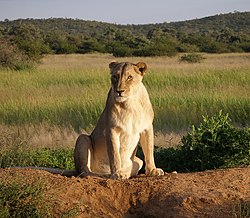 メス | |||||||||||||||||||||||||||
| 保全状況評価[1][2][3] | |||||||||||||||||||||||||||
| VULNERABLE (IUCN Red List Ver.3.1 (2001)) 
| |||||||||||||||||||||||||||
| 分類 | |||||||||||||||||||||||||||
| |||||||||||||||||||||||||||
| 学名 | |||||||||||||||||||||||||||
| Panthera leo (Linnaeus, 1758)[4][5][6][7] | |||||||||||||||||||||||||||
| シノニム | |||||||||||||||||||||||||||
|
Felis leo Linnaeus, 1758[3][4]
| |||||||||||||||||||||||||||
| 和名 | |||||||||||||||||||||||||||
| ライオン[6][8][9] | |||||||||||||||||||||||||||
| 英名 | |||||||||||||||||||||||||||
| Lion[4][6][7][8] | |||||||||||||||||||||||||||
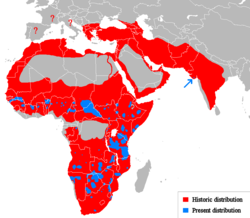 アフリカ大陸における分布 |
語源[編集]
ロマンス語の多くで見られる類似した名前﹁ライオン lion﹂は、ラテン語のleo、古代ギリシア語のλέων(leon)に由来している[12][13]。またヘブライ語の לֶוִי (lavi)や古代エジプト語のrwともつながりがある[14][15]。カール・フォン・リンネが18世紀に著した﹃自然の体系︵Systema Naturae︶﹄で、元々 Felis leo ︵ネコ属のライオン︶として分類された多くの種のひとつである[16]。︵その後分類が再編され、ライオンは﹁Panthera︵ヒョウ属︶﹂に入れられた。︶分布[編集]
アンゴラ、ウガンダ、エチオピア、カメルーン、ケニア、コンゴ民主共和国、ザンビア、ジンバブエ、スーダン、エスワティニ(旧スワジランド)、セネガル、ソマリア、タンザニア、チャド、中央アフリカ共和国、ナイジェリア、ナミビア、ニジェール、ブルキナファソ、ベナン、ボツワナ、マラウイ、南アフリカ共和国、南スーダン、モザンビークに分布[3]。 ガーナ、ギニア、ギニアビサウ、コートジボワール、トーゴ、マリ、ルワンダでは絶滅したと考えられる[3]。アフガニスタン、アルジェリア、イラク、イラン、エジプト、エリトリア、ガボン、ガンビア、クウェート、コンゴ共和国、サウジアラビア、シエラレオネ、ジブチ、シリア、チュニジア、トルコ、パキスタン、ブルンジ、モーリタニア、モロッコ︵西サハラ含む︶、ヨルダン、リビア、レソト、レバノンでは絶滅[3]。 模式標本の産地︵模式産地︶は単にアフリカとされていたが、バーバリ地方の沿岸部やコンスタンティーヌ︵アルジェリア︶とする説もある[4]。壁画などから15,000年前にはヨーロッパ広域にも分布し、5,000年前には少なくともギリシアには分布していたと考えられている[9]。生息地[編集]
アフリカでは、アカシアの木がまばらに生えて影ができているサバンナの草原地帯でライオンたちを見ることができる[17]。インドでの生息地は乾燥したサバンナか、さらに乾いた落葉樹林のなかである[18]。ヘロドトスの記すところによれば、ライオンは紀元前480年頃にはギリシアでよく知られる動物となった。ペルシアの王クセルクセス1世が国中を練り歩いているなか、そのラクダの積荷をライオンが襲ったことが記されている。アリストテレスは紀元前300年にはもう彼らが貴重な動物だと考えていて、その後400年ほどして彼の地でのライオンは絶滅している[19]。亜種インドライオンは10世紀頃まではヨーロッパの辺境であるコーカサス地方にもいたと考えられている[20]。 パレスチナに由来する種も中世には姿を消した。アジアのほとんどの地域でも、猟銃が簡単に手に入る18世紀頃になるとライオンの姿は見られなくなった。19世紀の終わりから20世紀初めにかけて、北アフリカおよび東南アジアでも絶滅している。トルコおよびインド北部のほぼ全域も同様である[21]。アジアで最後にライオンが確認されたのは1941年のイランである[要校閲]が、3年後にはカールーン川の岸辺で死骸となって発見された。その後、イランでは信頼できるレポートは送られていない[22]。最後に生き残った亜種インドライオンはインド北部のギルの森周辺でみることができる[23]。そこはグジャラート州に属する、ほとんどが森に覆われた1412平方キロメートルの土地であり、300頭ほどのライオンたちの聖地となっていて、その数はゆっくりと増えているという報告もある[24]。形態[編集]
頭胴長︵体長︶オス170 - 250センチメートル、メス140 - 175センチメートル[4]。尾長オス90 - 105センチメートル、メス70 - 100センチメートル[8]。肩高オス123センチメートル、メス107センチメートル[4]。体重オス150 - 225キログラム、メス120 - 182キログラム[4]。オスはケニア山の近くで体重272キログラムの記録もある[4]。頭部は太くて短く、丸みを帯びる[9]。背面の毛衣は黄褐色や赤褐色、腹面や四肢内側の毛衣は白い[6][9]。耳介背面は黒い体毛で被われる[9]。尾の先端には房状に体毛が伸長し、色彩は暗褐色や黒[6]。 出産直後の幼獣の体重は1 - 2キログラム[8]。幼獣には暗色斑が入るが、成長に伴い消失する[6][9]。 オスの成獣は頭部から頸部にかけて、たてがみが発達する[6]。野生下では南アフリカ共和国の南部および東部で、標高1,000メートル以上の環境に生息する個体群でたてがみが発達する傾向がある[5]。一方でケニアからモザンビーク北部にかけてやサヘル地域などの暑い地域に生息する個体群ではたてがみはあまり発達せず、たてがみがない個体もみられる[5]。飼育個体でも北半球で冬季が寒冷な地方では、たてがみが発達する傾向がある[5]。強いオスはテストステロンの分泌が多く、それにより、たてがみの色が濃くなる[25]。このため、メスにアピールするのはたてがみの多さではなく、たてがみの色の濃さが重要となる[25]。 ライオンの体重に置ける筋肉の重さ︵骨格筋率︶は58.8%でありこれは哺乳類最高比率である[26][27]。分類[編集]
| |||||||||||||||||||||||||||||||||||||||||||||||||||||||||||||||
| Barnett et al.,(2014)より絶滅個体群の標本も含めてミトコンドリアDNAシトクロムbの塩基配列を決定しベイズ法によって推定された系統樹[28] |
- 化石記録
| ||||||||||||||||||
| Li et al. (2016)[29]、Piras et al. (2018)[30]によるライオン、ホラアナライオン、アメリカライオンの系統関係。 |
生態[編集]

習性[編集]
一日のほとんどを寝そべり、およそ20時間ほどを怠惰に過ごす[31]。日中にも行動することはあるが、たいてい最も活動的になるのは夕暮れより後であり、それから社会的な行動や身づくろい、排泄などを行う。狩りが最もよく行われるのは日が昇る前の夜間であり、断続的に活発な行動を起こす。平均して2時間ほど動き回り、50分間を食事に費やす[32]。集団行動[編集]


狩りと食性[編集]

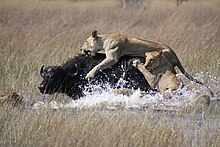


繁殖と生活周期[編集]
通常、ライオンは4歳頃に受胎が可能となる[63]。交尾の時期は決まっておらず、発情期のようなものはない[64]。他のネコ科の動物のように、オスはペニスに傘状の﹁突起﹂を持っている。この﹁突起﹂がメスの性器を刺激し、排卵を促す[65]。メスが一頭のオスとだけ交尾するということはまずなく、交尾期には複数のオスと接触するのが普通である[66]。交尾は数日かけて行われることもあり、番のライオンはたいてい食事をとらず1日におよそ20-40回の接合を行う。また飼育個体は妊娠しやすい傾向にある。


コミュニケーション[編集]
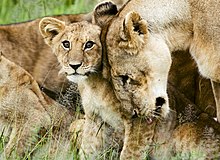
捕食者同士の争い[編集]
本種とブチハイエナが同所的に分布している地域では、この2種が同じ生態学的なニッチを占めて対立することになる。時には全体の食糧の68.8%が重なってしまうことがある[84]。ンゴロンゴロ保全地域では本種がブチハイエナの倒した獲物を奪うことが日常的になっていて、ブチハイエナの高い死亡率につながっている。ハイエナたちが食事をする時の呼び声をテープで再生すると、本種が現れるという報告例もある[85]。命の危険に晒されたブチハイエナはすぐその場から立ち去るか、30-100mほど距離を置いて食事が終わるまで待ち続ける[86]。一方でハイエナの数が圧倒的に優勢な時など場合によっては食事を続けたり、逆に本種に襲い掛かることもある。食糧とは関係ないところでもこの2種は対立することがあり、はっきりとした理由が見えないような状況で本種がハイエナに飛びかかり、傷を負わせたりする。1頭の雄ライオンが別々の場所でリーダー格の雌ハイエナ2頭をかみ殺した姿が記録されていて、このオスはハイエナを食事にしたわけではない[87]。エトーシャ国立公園のハイエナの71%は本種に襲われて死んでいる。ブチハイエナはライオンが繰り返し自分たちの縄張りに侵入してくるプレッシャーに耐えているのだ[88]。飼育されたブチハイエナである実験をすると、ライオンに全く接した経験のない個体はその姿を目にしても無関心であるが、匂いを嗅ぐと怯えだすということが明らかになった[85]。 チーターやヒョウといったライオンより小型のネコ科動物と共存している地域でも、ライオンは支配的な影響力を持つ傾向にあり、その獲物を奪うほか、子供たちや時には大人︵成獣︶でさえも捕食してしまう。チーターがその獲物をライオンや他の捕食者に奪われる確率は50%にもなる[89]。ライオンはチーターの子供にとって最大の脅威であり、襲われて生後1週間で命を落とす子供は実に90%に達する。チーターは時間を細かくずらして狩りを行い競合を避け、子供たちは深い茂みに隠しておく。ヒョウも同じような戦略を使っているが、チーターと違ってヒョウは木登りが得意であり、そこに子供たちを置くことでライオンから身を守っている。しかし、雌ライオンは時々ヒョウの獲物を奪うために木に登ることがある[90]が、ヒョウ程高い所までは登れない。リカオンに対してもライオンは優位に立ち、獲物を奪いとるだけでなくまた稀にリカオンの子供や大人を狩ることもある。 アフリカニシキヘビも彼らの捕食対象となる。 陸に上がったナイルワニはライオンに狩られるが、水辺ではライオンがワニの餌食になる事もあり、相互に補食と被食の関係にある。人間との関係[編集]
人間を襲うことは少ないが、一部の地域では人間を獲物と認識しており、ごくまれに継続的に人間を襲う例もある[5] 開発による生息地及び獲物の減少、毛皮や肉目的の狩猟、娯楽としての乱獲、毒餌による中毒死、害獣としての駆除などにより生息数は減少している[8][9]。セレンゲティ国立公園では1993 - 1994年に犬ジステンパーの流行により1,000頭以上の大量死が発生し、生息数が激減した[5]。1977年にネコ科単位でワシントン条約附属書II、2019年にインドの個体群のみワシントン条約附属書Iに掲載されている[2]。1975年のワシントン条約発効時から亜種インドライオンがワシントン条約附属書II、1977年にはワシントン条約附属書Iに掲載されていたが、2019年に分類の変更に伴い亜種インドライオンの掲載は抹消されインドの個体群としてワシントン条約附属書Iに掲載されている[2]。 アフリカ大陸西部個体群 CRITICALLY ENDANGERED (IUCN Red List Ver. 3.1 (2001))[3] P. l. persica インドライオン
1900年に領主により、狩猟が規制されたギルの森を除いて絶滅した[91]。生息地は国立公園として保護されている[91]。現在は生息地の国立公園への追加指定や、国立公園内から人や家畜を放出する保護対策が進められている[91]。1963年における生息数は285頭、1969年における生息数は177頭と推定されている[91]。
ENDANGERED (IUCN Red List Ver. 3.1 (2001))[3]
P. l. persica インドライオン
1900年に領主により、狩猟が規制されたギルの森を除いて絶滅した[91]。生息地は国立公園として保護されている[91]。現在は生息地の国立公園への追加指定や、国立公園内から人や家畜を放出する保護対策が進められている[91]。1963年における生息数は285頭、1969年における生息数は177頭と推定されている[91]。
ENDANGERED (IUCN Red List Ver. 3.1 (2001))[3]
 日本では2020年の時点でパンテラ属︵ヒョウ属︶単位で特定動物に指定され、2019年6月には愛玩目的での飼育が禁止された︵2020年6月に施行︶[92]。
ヘロドトスとアリストテレスは、ヨーロッパにはアケローオス川︵アヘロオス川︶とネッソス川︵メスタ川︶の間にだけライオンが生息していると記した[93]。この地のライオンは、紀元前480年に古代ギリシア征服︵ペルシア戦争︶のため行軍中のペルシア軍の輸送隊のラクダを襲った[94]。
日本では2020年の時点でパンテラ属︵ヒョウ属︶単位で特定動物に指定され、2019年6月には愛玩目的での飼育が禁止された︵2020年6月に施行︶[92]。
ヘロドトスとアリストテレスは、ヨーロッパにはアケローオス川︵アヘロオス川︶とネッソス川︵メスタ川︶の間にだけライオンが生息していると記した[93]。この地のライオンは、紀元前480年に古代ギリシア征服︵ペルシア戦争︶のため行軍中のペルシア軍の輸送隊のラクダを襲った[94]。
象徴[編集]


-
錬金術の書物に頻繁に登場するモチーフ「緑のライオン(Leo viridis)に食い尽くされる太陽」
-
殺戮と伝染病の女神セクメト
文化[編集]
保全状態[編集]
2002-2004年現在のアフリカでの野生個体数は16500-47000頭と推測されているが、1990年代初めになされた調査では1950年には10万-40万頭までいたとされていた[96][97]。生息地の減少と人間との衝突が種を脅かす最大の原因と考えられる[98][99]。ライオンたちがいま生き残っている地域はそれぞれが孤立した状態にあり、近親繁殖が進んでしまうため、遺伝的な多様性が失われている。西アフリカにおけるライオンの数は中央アフリカのそれと非常に差があり、交配する個体の交替が全くと言っていいほどなされない。 保護には国立公園や禁猟区を設置し維持することが求められる。ザンビアのエトーシャ国立公園、タンザニアのセレンゲティ国立公園、南アフリカのクルーガー国立公園などが有名である。このエリアの外では人間や家畜と接触するために問題が起こってしまうため、たいていライオンのほうが排除される[100]。亜種インドライオンはインド西部にあるギル国立公園が最後の生息地となっている。そこは1,412平方キロメートルの面積を持ち、2006年4月の時点でおよそ359頭の生息が確認されている。アフリカと同様にこの公園に非常に近いところに大勢の人間が暮らしているため、ライオンと家畜や地元民、保護団体のあいだで問題が生じている[101]。亜種インドライオンを復活させるプロジェクトが計画され、インドのマディヤ・プラデシュ州にある野生動物保護区に複数頭がまとめられた.亜種インドライオンが生き残るためには遺伝子プールとを確保し、遺伝的多様性を広げ、維持することが重要なのである。
人食いライオン[編集]
ふつう人を襲うことはないが、例がないわけではない。非常に有名になったものにツァボの人食いライオンがいる。これは1898年にケニア︵当時はイギリス領東アフリカ︶のツァボ川に架橋する工事の最中に起こった悲劇で、ケニア-ウガンダ間に鉄道を敷くための9ヶ月に合計で28人の工夫が犠牲になったものである。1991年にはザンビアでも事件が起き、ムフエのルアングワ渓谷で6人がかみ殺されている[105]。この人食いライオンたちを撃ち殺したハンターは、ライオンたちが捕食行動を行っていたと詳細に記している。ツアボとムフエの事件には類似点が見られ、どちらのライオンも平均よりも巨大な体躯を持ち、たてがみがなかった。そして虫歯に苦しんでいるらしきところも共通していたが、この虫歯も含めた疾患によるストレスという説を支持する研究者は皆無である。博物館のコレクションに加えられた人食いライオンたちの顎と歯の分析が示しているのは、虫歯はいくつかの付随的な条件を示すことはあるかも知れないが、ライオンたちが人を襲ったのは人間の多い地域で食糧が不足したためだという可能性が最も高いということである[106]。ツアボの事件を中心に人食いライオン一般を研究した学者は、病気になったり傷を負ったライオンが人を襲う傾向にあることは認めたが、そういった行動は決して異常ではなく、機会さえあればむしろ当然のものだとしている。家畜や人間に遭遇するなどの要因さえあれば、ライオンはいつでも人間を獲物にしうるということである。著者たちはこういった人間との関係は古生物学の記録によればヒョウや他の霊長類にも十分に確認できると記している[107]。ライオンがどのように人を襲うのかという傾向については体系だてられた調査が存在する。アメリカとタンザニアの科学者は、タンザニアの地方でライオンの被害が増加していると報告している。それによれば1990年から2005年にかけて数が増しており、少なくとも563の村が襲われ、1世紀も前に有名になったツアボの事件の被害者数をはるかに越えるスピードで人間が殺されている。たとえばルフィジ県のセルー国立公園周辺やモザンビーク国境沿いのリンジ地方などで事件が多発している。人口が増えてより辺境に暮らす人が多くなったことも原因の一つだが、著者たちが主張しているのはライオンの保護プログラムが危険を放置したままにしているということである。これらのケースではプログラムがそのまま被害につながっているからである。リンジでのケースは、村から出た人間がライオンに襲われた例として記録されている[108]。
飼育[編集]
概要[編集]

ライオンバス[編集]
東京都日野市の多摩動物公園のライオン園では﹁ライオンバス﹂と呼ばれるサファリバスが運行している[119]。バスに乗って間近でライオンを観察することができ、運営は東京動物園協会、運転は京王電鉄バス株式会社に委託されている。1963年に東京都台東区の恩賜上野動物園で実験が行われ、1964年5月から多摩動物公園での世界初の運行が実施された。運行開始直後から人気を集め、開始から2年で累計乗車数は100万人を越えた。2000年5月には従来のディーゼル車から、圧縮天然ガス自動車に切り替え、環境への配慮も行われた。2016年から耐震工事のため長期運休となっていたが、2021年7月に運行が再開した[120]。歴史[編集]
紀元前850年頃にはアッシリア王によって飼育された[19]。アレクサンドロス3世︵アレクサンダー大王︶もまた北インドから調教された個体を献上されたといわれている[121]。古代ローマでは、皇帝たちは剣闘士と戦わせるようになる。スッラやポンペイウス、カエサルといった名高い人物たちはしばしば一度に何百頭という個体を集めて殺戮させるよう命じていた[122]。東洋ではインドの王妃が飼育した。マルコ・ポーロの記すところによれば、クビライ・ハンは室内にライオンを飼っていたという[123]。ヨーロッパで初めて﹁動物園﹂が貴族や王家の間だで流行したのは13世紀のことである。17世紀頃までにはハーレム(seraglios)と呼ばれ、驚異の部屋の延長として当時は見世物小屋(menageries)という名も定着していた。ルネサンス期にはフランス、イタリアからヨーロッパ全土へと広がった[124]。イギリスではこのハーレム文化があまり栄えることはなかったが、13世紀にジョン王がロンドン塔につくったハーレムの中で飼われていた。おそらく1125年にヘンリー1世が始めた初期の見世物小屋が起源だと考えられる[125][126]。それはオックスフォードのそばのウッドストック近くにあり、マームズベリのウィリアムはライオンたちがそこで飼われていたと記録している[127]。 こういった施設は貴族の富と権力とを表すものであり、とりわけ巨大なライオンやゾウたちのような動物はそのまま力のシンボルとなった。これは突き詰めると、人間が自然を支配しているということを誇示するためのものでもあった。ライオンのような大自然の﹁王﹂が怯える姿や、サイを前にしたゾウが尻込みする様に17世紀の好事家たちは驚き、そして喜んだのだった。見世物小屋が一般大衆に受け入れられるようになると、このような動物同士の決闘は次第に見られなくなっていった。大型動物をペットにするという伝統は19世紀まで続くが、その頃にはかなり奇矯な振る舞いとみなされるようになった[128]。
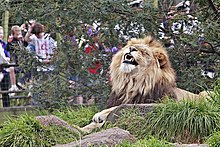
調教[編集]

養殖と狩猟[編集]
南アフリカ共和国などの国では、単に種の保存を目的とするだけでなく、狩猟用に飼育されている場合がある。このようなライオンたちは、幼獣の時期にはエコツーリズムなどの観光の資源として利用される。観光客は代金を支払い、子ライオンを抱いたり、ミルクを与えたりして楽しむ。そしてライオンは成長すると、狩猟のために野に放され、狩猟愛好家の標的となる。生まれた時から人間に飼育されたライオンに、猟師から逃れるすべはない。狩猟の顧客はアメリカ人が多い[143]。 東洋においてトラの骨の酒︵虎骨酒︶が珍重されているが、20世紀末になるとトラは保護され、代わりにネコ科の大型獣が用いられるようになった。2008年よりライオンの骨も利用され、養殖されたライオンの骨が国際取引される[144]。特徴[編集]

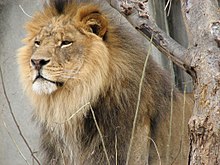
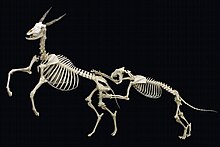 ネコ科で唯一の尾の先に房状の毛が生えているが、その役割はわかっていない。5mmほどの硬い棘や突起を房の中にしまっている個体もいる。房のある尻尾をもった動物なのだが、生後5か月と半月ほどで房が生えはじめ、7か月もするとはっきりそれとわかるようになる[149]。
ネコ科で唯一の尾の先に房状の毛が生えているが、その役割はわかっていない。5mmほどの硬い棘や突起を房の中にしまっている個体もいる。房のある尻尾をもった動物なのだが、生後5か月と半月ほどで房が生えはじめ、7か月もするとはっきりそれとわかるようになる[149]。
たてがみ[編集]
オスの成獣が持つたてがみは、ネコ科のなかでも独特のもので最も明示的な種の特徴の一つである。たてがみは外観をより大きくみせ、威嚇的に振舞うためには完璧といっても良いほどの役割を果たす。それは他の個体やアフリカでの主な競争者であるブチハイエナたちと対峙する場合も同じである[150]。たてがみの有無、色、毛の量は遺伝的要因、生育状況、テストステロンの量、気候などに影響される。大まかに言って、より黒くたっぷりとしたたてがみを持ったライオンほど健康である。交尾の相手としても、より濃く、黒い色をしたたてがみをもっているライオンほどメスに好まれる[151]。 タンザニアでの調査もたてがみの長さがオス同士の戦いでの強さを裏づけている。一年を通じて非常に暑い時期が続くにもかかわらず、より暗色のたてがみをもつ個体ほど多産であり、子孫も繁栄しやすい[152]。2、3頭のオスの連合体となるプライドでは、より大きいたてがみを持つオスのほうが積極的に交尾をせがまれるということがしばしばである[151]。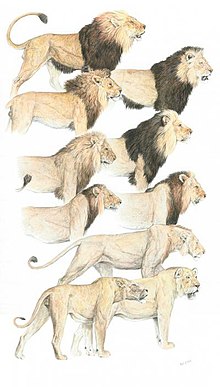

メスのたてがみ[編集]
普通、たてがみはオスの個体のみが持つものであるが、稀にメスの個体で、オスのものほど立派ではないにしろ、たてがみを持つものが確認されることがある。アメリカ、カンザス州のトピカ動物園で飼育されているメスのライオン﹁ズーリ﹂は、2020年10月にトピカ動物園最後のオスのライオンである﹁アブス﹂が死亡した後から、たてがみが生え始めたという。また、外見だけではなく行動も、唸り声や吠え声をあげたり、通常のオスに近い行動をとるようになってきたそうだ。同様の事例は、2011年に南アフリカの動物園で、2018年にはアメリカ、オクラホマ州の動物園で確認されている。また、野生でも2016年の論文ではボツワナで5件確認されたと報告されている。 メスにたてがみが生えるメカニズムについては諸説あり、﹁メスだけになった状況で、群れを守る必要が出てきたため、テストロテンの分泌量が増えたから﹂という説や﹁状況に関係なく、加齢などの影響で、ホルモンのバランスが崩れたから﹂という説などがある[157]。ホワイトライオン[編集]
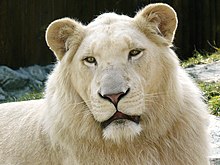
雑学[編集]
ライオンを由来とする商標[編集]
●ライオン (企業) - ライオン株式会社の創業は1891年、当時は小林富次郎商店と言った。﹁ライオン歯磨﹂の発売は1896年。小林が知り合いの牧師に商品名を相談して﹁ライオンは歯が丈夫であるし商品の名前としてうってつけではないか﹂と言われて付けた。 ●ライオンズマンション - 一部の物件で入り口に座ったライオンの銅像が置いてある。ライオンの名前の由来は群れで行動し、家族を大切にするライオンにあやかり、マンションに住む住人たちの家庭円満を願ってのものである。 ●スバル・レオーネ - イタリア語の﹁雄ライオン﹂から、﹁獅子座宮星座﹂﹁勇者﹂という意味も込めて命名された。著名な創作物[編集]
●野生のエルザ - いくつかの書籍や映画にまとめられたライオンの保護飼育の記録。 ●グレートハンティング - ライオンの人食いシーンが登場してヒットしたイタリア映画。 ●ジャングル大帝 - 手塚治虫原作の漫画とアニメ。白いライオン﹁レオ﹂の物語。 ●ライオン・キング - アフリカを舞台としたライオンの王の物語。 ●ライオン・ガード - ﹃ライオン・キング﹄の後日談。プライドランドの王﹁シンバ﹂の息子﹁カイオン﹂と仲間達がプライドランドを守る物語。その他[編集]
●ディスカバリーチャンネルの専門家達による一対一の殺し合いのシミュレートでは、ライオンはアフリカゾウには負けるが、トラ、シロサイ、カバ、ヒグマ、セイウチには勝つと判断され、百獣の王の名に恥じぬ結果となっている[161]。 ●埼玉西武ライオンズ - 日本のプロ野球球団。パシフィック・リーグに所属している。脚注[編集]
注釈[編集]
出典[編集]
参考文献[編集]
- Juliet Clutton-Brock 著、株式会社リリーフ・システムズ 訳『ネコ科の動物』株式会社 同朋舎出版〈ビジュアル博物館〉、1992年。ISBN 978-4810410884。
- Baratay, Eric; Elisabeth Hardouin-Fugier (2002). Zoo : a history of zoological gardens in the West. London: Reaktion Books. ISBN 1861891113
- Blunt, Wilfred (1975). The Ark in the Park: The Zoo in the Nineteenth Century. London: Hamish Hamilton. ISBN 0241893313
- de Courcy, Catherine (1995). The Zoo Story. Ringwood, Victoria: Penguin Books. ISBN 0140239197
- Schaller, George B. (1972). The Serengeti lion: A study of predator-prey relations. Chicago: University of Chicago Press. ISBN 0226736393



